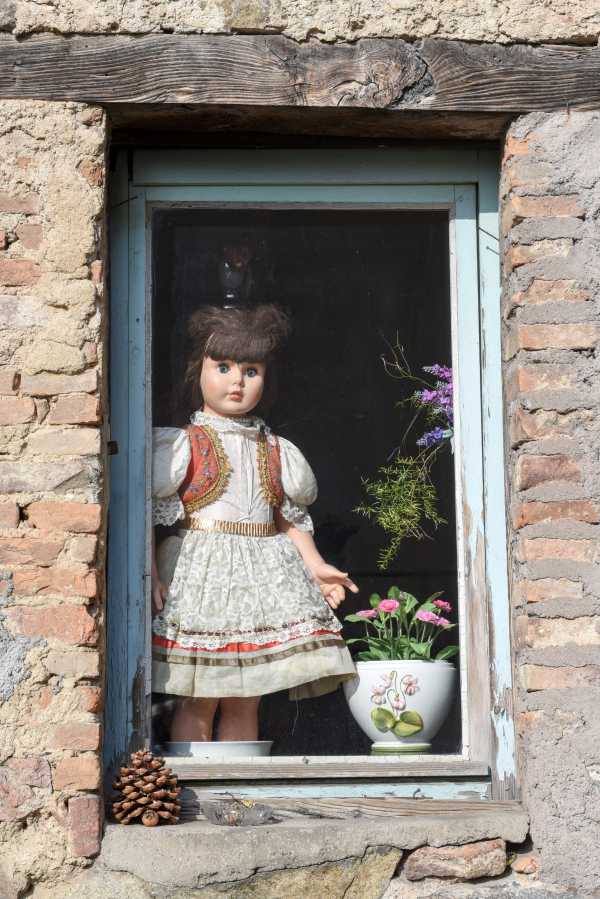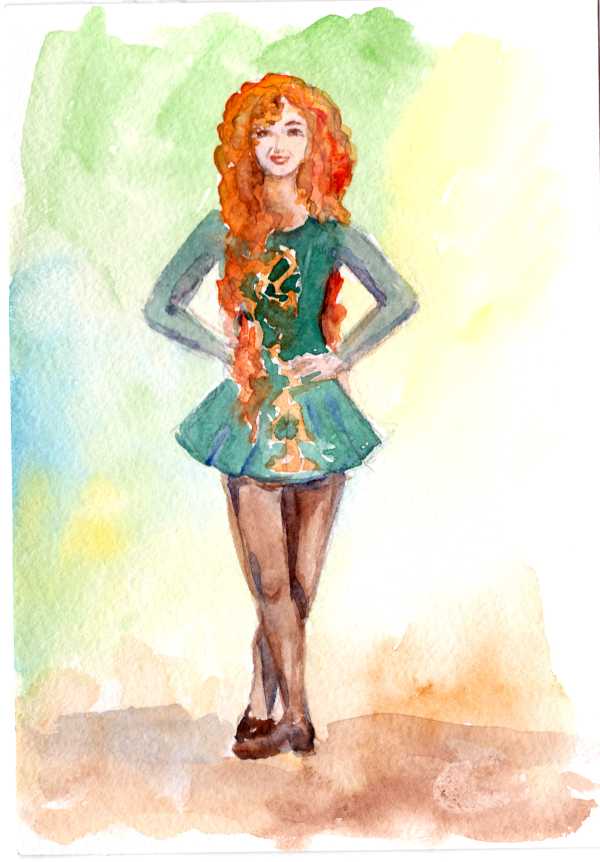
Jennifer Devore
JennyPop's Mental / Baseball x Irish Dance: Superstitions, Beliefs and Lucky Charms
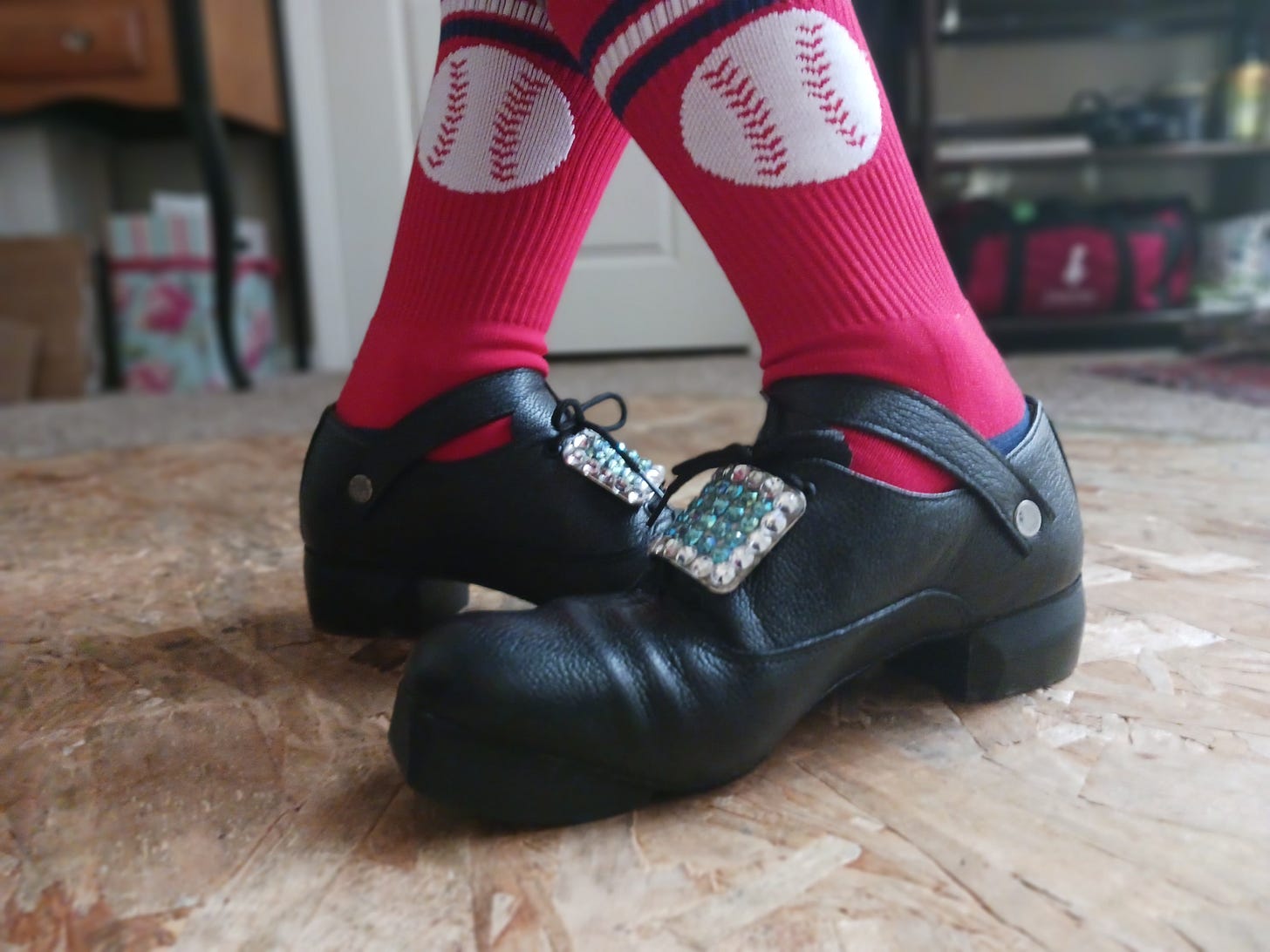
Even really smart folk can be superstitious. Sure, science and logic objectively trump magic and emotion. Still, once the realities of pragmatism are acknowledged, isn't there room for a little something extra: like a decadent, après-dinner snackie? Think of superstitions as a crème brûlée or a German Riesling, or Cheez-Its: unnecessary, lacking any substance, yet, for some reason, once you've indulged, you feel a little better about everything.
Now that Spring Training is here (meaning, we fanatics survived the off-season and baseball is back!), what better time to indulge in a few silly superstions, odd rituals and nonsensical compulsions? History proves such behaviour is not only commonplace, but, the odder the behaviour, it might actually work.

Babe Ruth (OF, LHP; Boston Red Sox 1914-1919; New York Yankees 1920-1934; Boston Braves - manager - 1935) employed the protection of women's silk stockings, worn on off-days, to banish batting slumps.
Both Babe Ruth & Joe DiMaggio (CF; New York Yankees 1936-1951) made pertinent efforts to tap 2nd base on their way back to the dugout, from the outfield.
David Ortiz (a.k.a. Big Papi; DH, 1B; MinnesotaTwins 1997-2002; Boston Red Sox 2003-2016) had a detailed pre-batting ritual. Before stepping into the batter's box, whilst still in the on-deck circle, leaned his bat against his right leg, spat into his left hand and clapped.
Wade Boggs (3B; Boston Red Sox 1982-1992; New York Yankees 1993-1997; Tampa Bay Devil Rays 1998-1999) fielded precisely 150 ground balls every practice and consumed a whole chicken before each game. Baby Boggs really likes chicken! So much so, later he wrote his own chicken cookbook: “Fowl Tips: My Favorite Chicken Recipes”. Inevitably, to-date, he is a.k.a. “Chicken Man”.
Between 1999 and 2004, Turk Wendell (RHP; Chicago Cubs 1993-1996; New York Mets 1997-2001; Philadelphia Phillies 2001-2003; Colorado Rockies 2004) always kept four pieces of black licorice in his mouth, per inning, while pitching. After the inning ended, he jumped “kangaroo-style” over the foul line and into the dugout. Once back in the dugout, he spat out the licorice and brushed his teeth. Next inning he pitched, four new pieces of licorice started the ritual all over again.
Roger Clemens (RHP; Boston Red Sox 1984-1996; Toronto Blue Jays 1997-1998; New York Yankees 1999-2003; Houston Astros 2004-2007) soaked himself in bonkers-hot water, pre-game, then had the hottest possible muscle liniment applied to his genitals before putting on his uniform. (Had it applied … what I really want to know, is who applied it? He couldn't; pitchers can't have greasy goop on their hands.)
Similar to Babe Ruth and his silk stockings - but taking it a step further - Jason Giambi (1B, LF, DH; Oakland A's 1995 -2001; New York Yankees2002-2008; Oakland A's 2009; Colorado Rockies 2009-2012; Cleveland Indians 2013-2014), when facing a batting slump or a persistent struggle on the field, sported a gold thong to change his luck.
Some players don't wear batters’ gloves; the direct friction from a bat-handle can cause callouses, making their hands stronger and tougher. Moises Alou (OF; Pittsburgh Pirates 1990; Montréal Expos 1990-1996; Florida Marlins 1997; Houston Astros 1998-2001; Chicago Cubs 2002-2004; San Francisco Giants 2005-2006; New YorkMets 2007-2008) employed a method most curious: regularly urinating on his own hands. The uric acid makes quick work of a hardening agent. This method, seemingly, worked: a .303 career batting-average and 332 career-homeruns.
Mark McGuire (1B; OaklandA's 1986-1997; St. Louis Cardinals 1997-2001), as a pro, wore the very same athletic supporter he wore in high school and in college, at USC … until it was stolen. Stolen! Who would steal that? (Wait, I might know a girl, a Trojan ginger … )
Derek Holland (LHP; Texas Rangers 2009-2016; Chicago White Sox 2017: San Francisco Giants 2018-2019; Chicago White Sox 2019; Pittsburgh Pirates 2020; Detroit Tigers 2021) , Taco Bell & Wendy's), claimed Taco Bell and Wendy's pre-game “pig-outs’ ($30 worth of fast food fuel) kept away the bad mojo. He was also known to sleep with old bats … baseball bats, not old women … Ha!
Brandon Marsh (LF; LAAngels 2021-2022; Philadelphia Phillies 2022-present) douses his trademark, long, stringy locks between every inning. The look is more greasy than wet, reminiscent of It's Always Sunny in Philadelphia's priest-turned-street rat, Rickety Cricket. Still, with a career 8.3 WAR (Wins Above Replacement value), he can Cricket all he likes.
Mike Hargrove (1B, LF; Texas Rangers 1974-1978; San Diego Padres 1979; Cleveland Indians 1979-1985) was infamous for driving pitchers, managers, fans and even broadcasters bonkers with his pre-batting rituals. Sportswriter and dedicated, Cleveland Indians reporter, Bob Sudyk, described just such a maddening, ceremonial, pre-bat compulsion.
“With machine-like precision, Hargrove approaches the plate, calls time, grabs some dirt, taps at his pants, sleeves, hitches up his waistband, adjusts his hair, taps down his helmet, squeezes his hand deeper into his batting glove, drains all the moisture from his mouth and steps in after raking some dirt in the batter’s box with his cleats.”
- Bob Sudyk, The Sporting News, May 31, 1980
Jarren Duran (a.k.a. Goldenboy; OF; Boston Red Sox 2021-present) wears his trademark, motivational F*CK ‘EM mantra on a red t-shirt under his jersey: a personal directive to wave off not only haters and nay-sayers, but his self-doubt and own, past mental-health struggles. The back of the shirt reads, Still Alive. He also has the empowering reminders embroidered into the linings of bespoke suits, sported on the 2024 MLB All-Star Red Carpet and at the 2024 MLB Awards Show.

Duran is an American League All-Star MVP, ranked 2nd in the League for games played: (160/162) and debuted on MLB's “Top Ten Right Now: Leftfielders” at No. 2. His 2024 Red Sox season slashed .285/.342/.492 with an .834 OPS, 75RBI, 8.7 WAR and led the entire Major League in doubles, tied for the lead in triples and knocked 21HR. I'd say his ritual, red tee and mantra are working. Go, Sox! Go, Goldenboy!
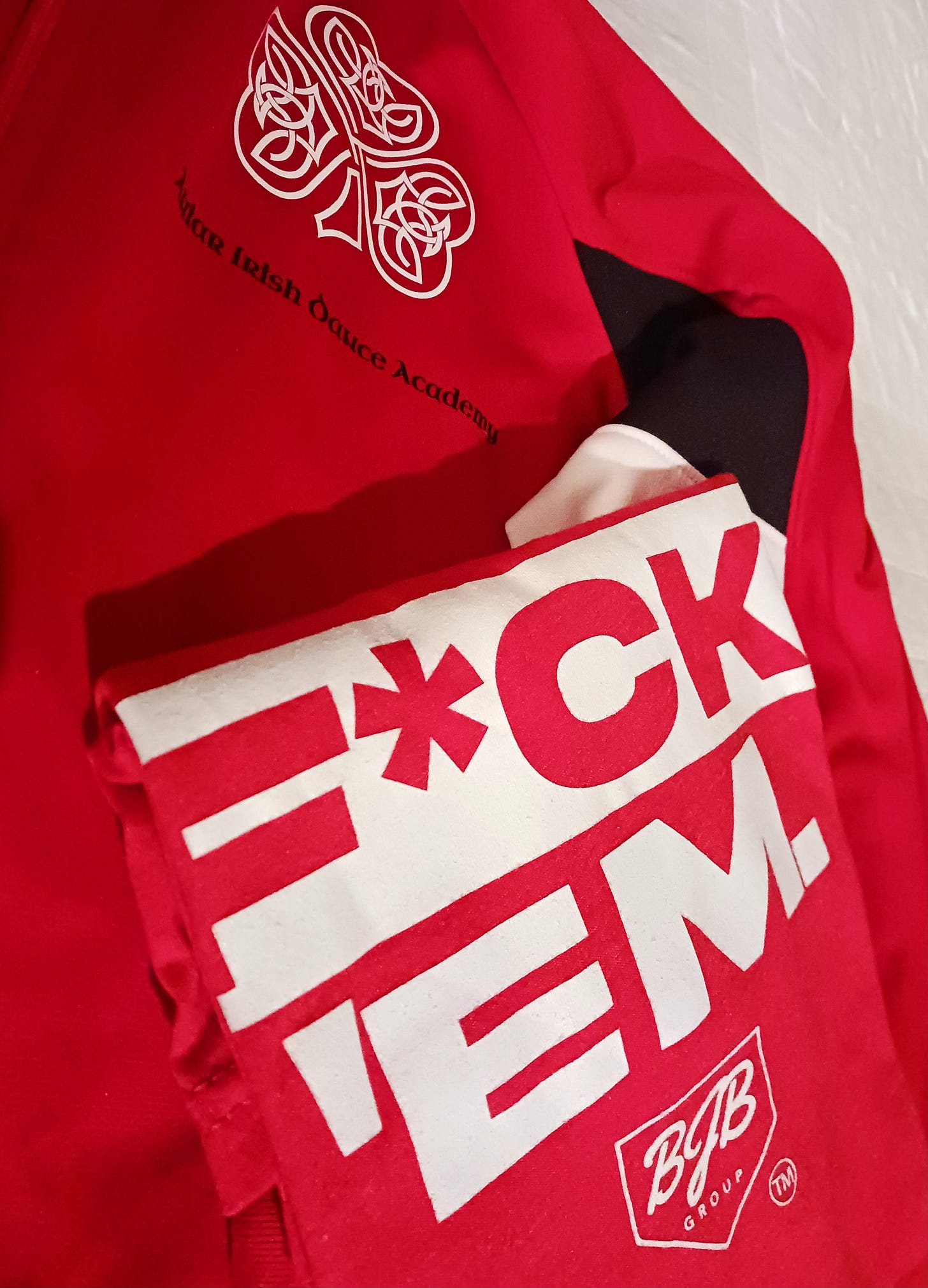
As with individual players, teams have their own good luck measures.
The 1894 Baltimore Orioles credited their National League pennant that year with a secret ingredient: gravy, on everything they ate.
The 2024 Chicago Cubs attributed a 7/12 gane winning streak to a random gift. Cubs manager Craig Counsell received a Taylor Swift candle as a present and took it to the Cubs’ clubhouse. There, he and clubhouse manager saw to it, that it was lit before every game. By the twelfth game, in seven of those games, the Cubs had made a total of seventy-three runs: the highest the Cubs had scored in a seven-game span since 1961.
Animals are, quite literally, the most natural of lucky talismans.
The San Diego Padres had a black panther statue in the dugout for a bit, which players pet for good luck: including Juan Soto when he played for the Pads (2022-2023). As of his 2025 15yr/$765M signing with the New York Mets, he is the highest-paid player in MLB history. That's some sizable luck there! Who's a good panther kitty?
More notably was the Padres’ rally goose, spiritually adopted after one landed on the field, at Dodger Stadium in L.A., during a Padres/Dodgers game in 2022. By “spiritually adopted”, I mean, there were, seemingly overnight, goose tees, plush, hats, etc., available online. Oh, Internet, you.
So, why did the Padres claim the away-game bird, rather the Dodgers doing so? It seemed a sign from above, considering still-cherished, still-mutton-chopped, former pitcher Goose Gossage (RHP, San Diego Padres 1984-1987).
There have been rally cats, rally squirrels, a rally snake (eww) and even a rally rat, after a little guy ran into the outfield during a Mets/Nationals game in Washington, D.C. When he was questioned by the media, as to why he ran out there, Ratty, a Mets fan, replied simply, “I wanted to know if the grass was spongy. It is.”
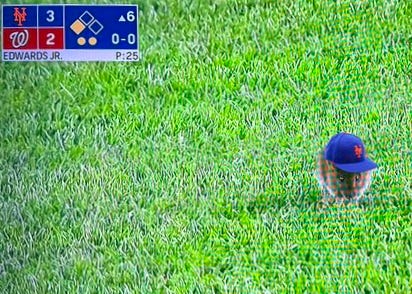
The most lovable animal, though, might be the L.A. Angels’ Rally Monkey. The original rally monkey was named Katie, when introduced in 2002, when the team was still kniwn, accurately, as the Anaheim Angels (they are still in Anaheim, in Orange County … there is no Los Angelesanythingabout Orange County). Katie posed and acted for all the rally monkey footage played on the big screen over the outfield.
It's important to know, Rally Monkeys only appear if the Angels are down by four or fewer runs, in the sixth inning or later. Then, they appear on-screen to their hop-up song, House of Pain's Jump Around (also happens to be Jarren Duran's walk-up song.)
Rally Monkeys do their jobs well. They rally the crowd, gets folks excited - thousands of $40 stuffed rally monkeys flailing and waving in the stands - and, most importantly, intimidate the opposing team.

I don’t like the Rally Monkey. I’m scared of the Rally Monkey. You’re out there in the outfield and the monkey just pops up on the screen. That’s kind of scary.
- Matt Kemp, L.A. Dodgers OF: excerpt from a 2012 AP interview
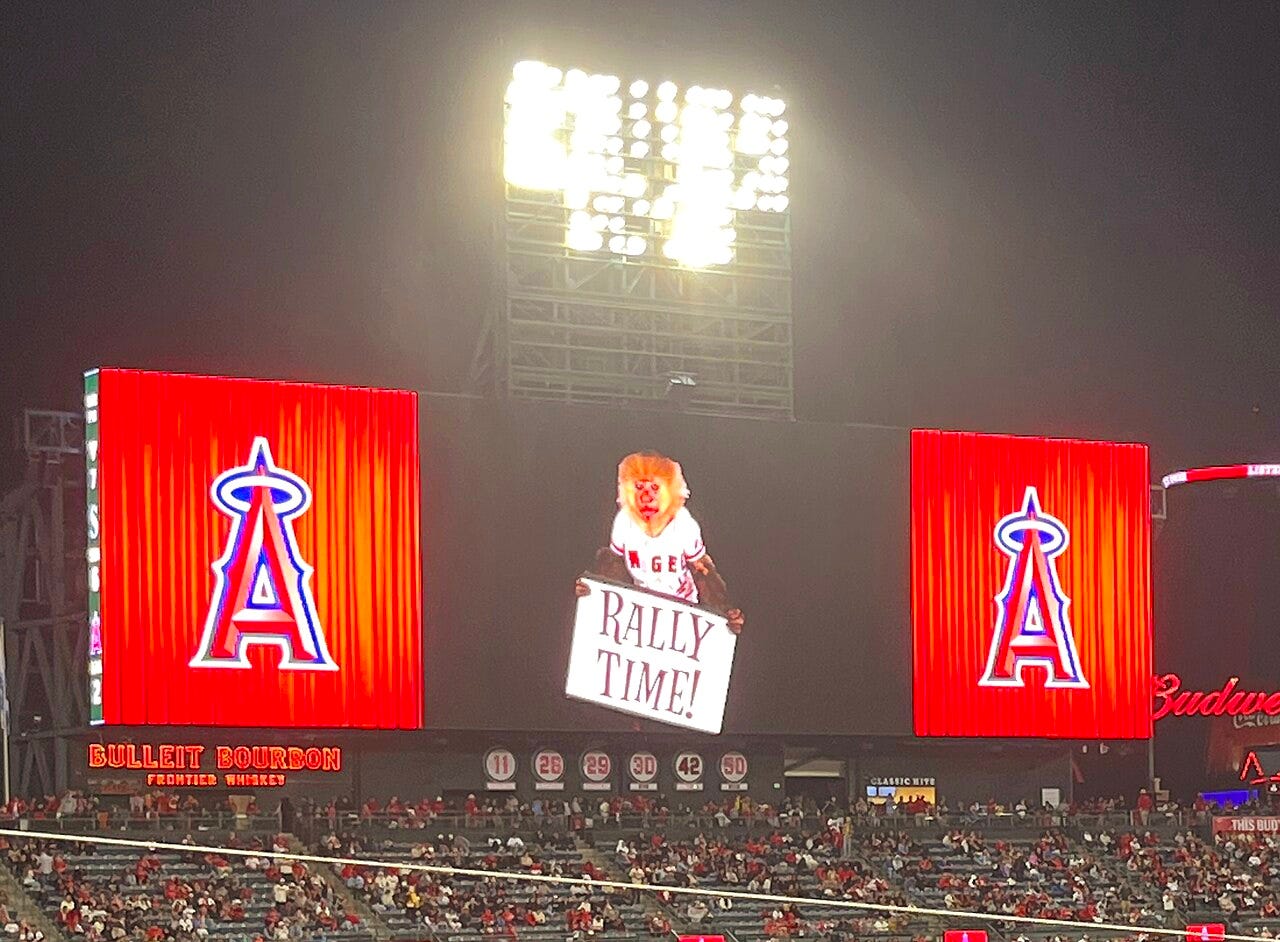
Of course, like naming a boat wrong, a well-intended good-luck measure can do you real mean sometimes …
August 10, 2024, on-field at Fenway Park, before a Boston Red Sox/Houston Astros game, Dave McGillivray (DMSE Sports, Inc.-founder and MA-based marathoner, entrepreneur, philanthropist and sporting-event organizer) graciously donated his 2024 Boston Marathon medal to the team, presenting it specifically to Jarren Duran. Known as one of the Sox’ most enthusiastic and supportive players, Duran is usually the teammate seen waiting at the dugout steps, holding aloft a distinct, blue-and-yellow marathon medal to celebrate HR-hitters, placing the medal around the neck … and maybe a nice pat on the head or the bum. Showing all the Bro-love. (Who doesn't love Bro-love?)
Note, there was already an identical good luck/celly medal: RS manager Alex Cora's very own which he earned completing the Boston Marathon's 5K race, before the 2024 Sox season began.

A reminder, looking back on the second-half of the 2024 RS season, you don't change a good luck charm mid-season. MacGillivray's gesture was a kind one; that's his thing, to give and share and promote hope. Still, after a phenomenal first-half of the season, starting that August 10th, the second-half fell, well, flat. Batting averages dropped, Ls stacked up, player slumps ensued, personal issues plagued some of the boys.
Whereas before mid-July's All-Star Game, in which the American League won (incl three Red Sox: Jarren Duran, Tanner Houck and Raffy Devers, who unfortunately was forced to sit out due to shoulder pain) there was such optimism for a post-season. Sadly, there came no playoffs, no post-season. Boston ended 2024 with a precisely mediocre season: 81W-81L.
A list can be a nice break from reading long paragraphs. Here's a nice list of Baseball's most common superstitions:
-
Pitchers jumping chalk lines (a.k.a. foul lines or baselines) heading to and from the mound
-
No talking about no-hitters or perfect games when a game is in progress
-
Repetitive batting stances and pre-batting rituals
-
Flipping a baseball cap inside out to start a rally (Generally applies to fans, bringing good luck to a team in the last inning.)
-
Leaving the pitcher alone on the day of his start, including no interviews or questions from the media
-
Crossing yourself, pointing skyward and kissing your bling after a home run
-
Using lucky bats and gloves
-
Players naming their bats
-
Eating certain foods before and during a game, especially sunflower seeds and gum
It's not only players and teams who are bonkers, of course. Fans’ behaviour should have (likey does) a billable, DSM-number for psychologists.
Yours Truly has her own game-day superstitions. Starting with gear, I have to wear a Red Sox tee (duh); but, it must be a specific tee based on varied factors like, home-game, away-game, certain players (slump/streak/verge of a record/etc). There's an emerald-green, blingy, “Lucky” barrette, a pretty Red Sox bow, and my blingy, shamrock bracelet which I must don, every game. If I forget, I must run upstairs, grab any missing pieces and hope I didn't do permanent damage.
I can't miss first pitch: especially if it's an away-game: Duran leads the Boston lineup and visiting teams always bat first. Baseball courtesy.
Any beverages must be consumed from RS barware.
River Monstering …
So, besides the Marathon medal, Boston also has a celly gesture known as River Monster: a clawing motion enacted by the whole team when a player gets on-base. My husband has to River Monster before each game. If he forgets, I remind him. If necessary, I can River Monster myself.
Let it be known, my ritual accessories and actions do work. The Red Sox 81-81, 2024 season proves that 50% of the time, all my baubles, bows, barware, behaviours, tees and River Monsters worked 100% of the time.
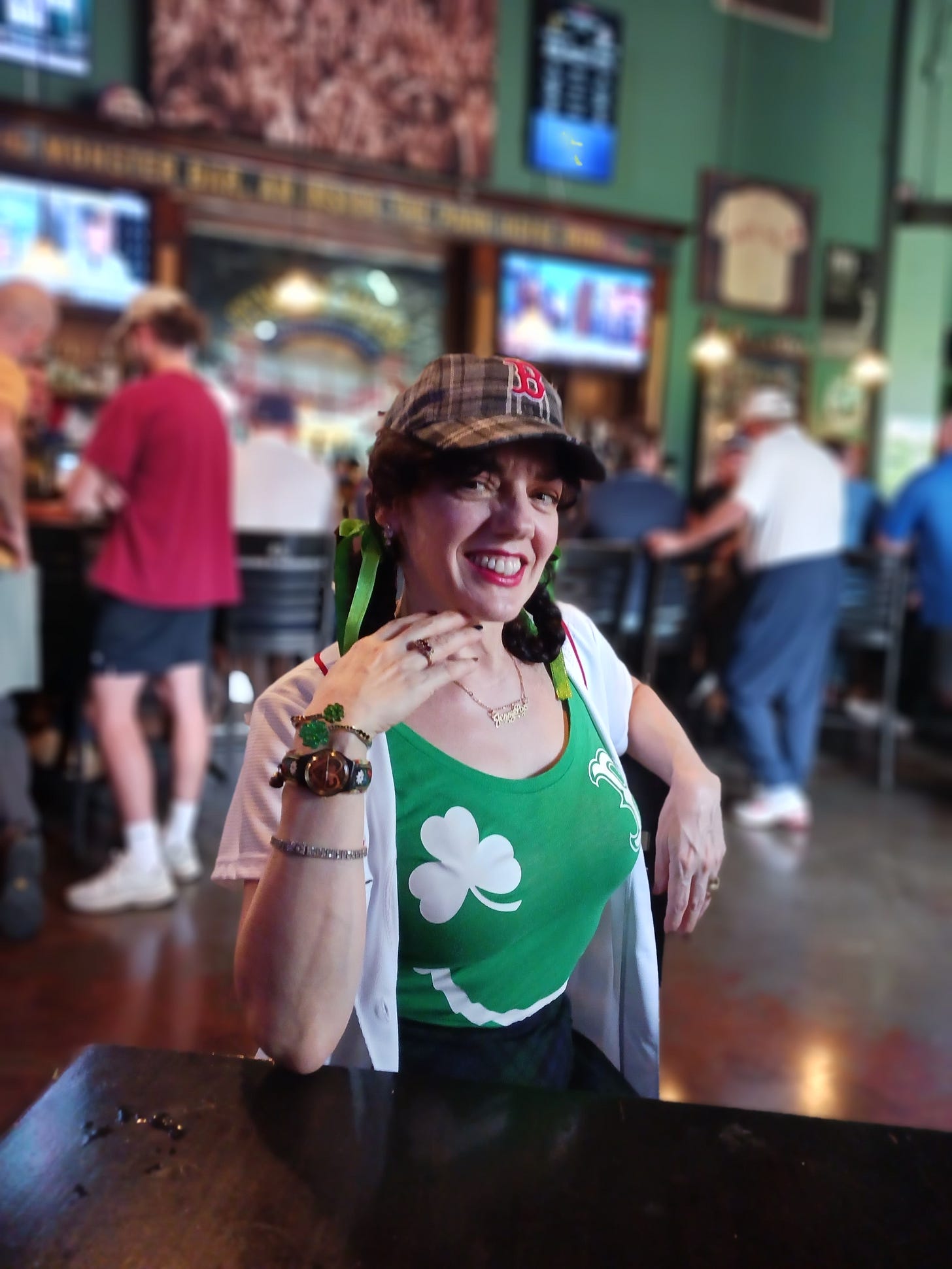
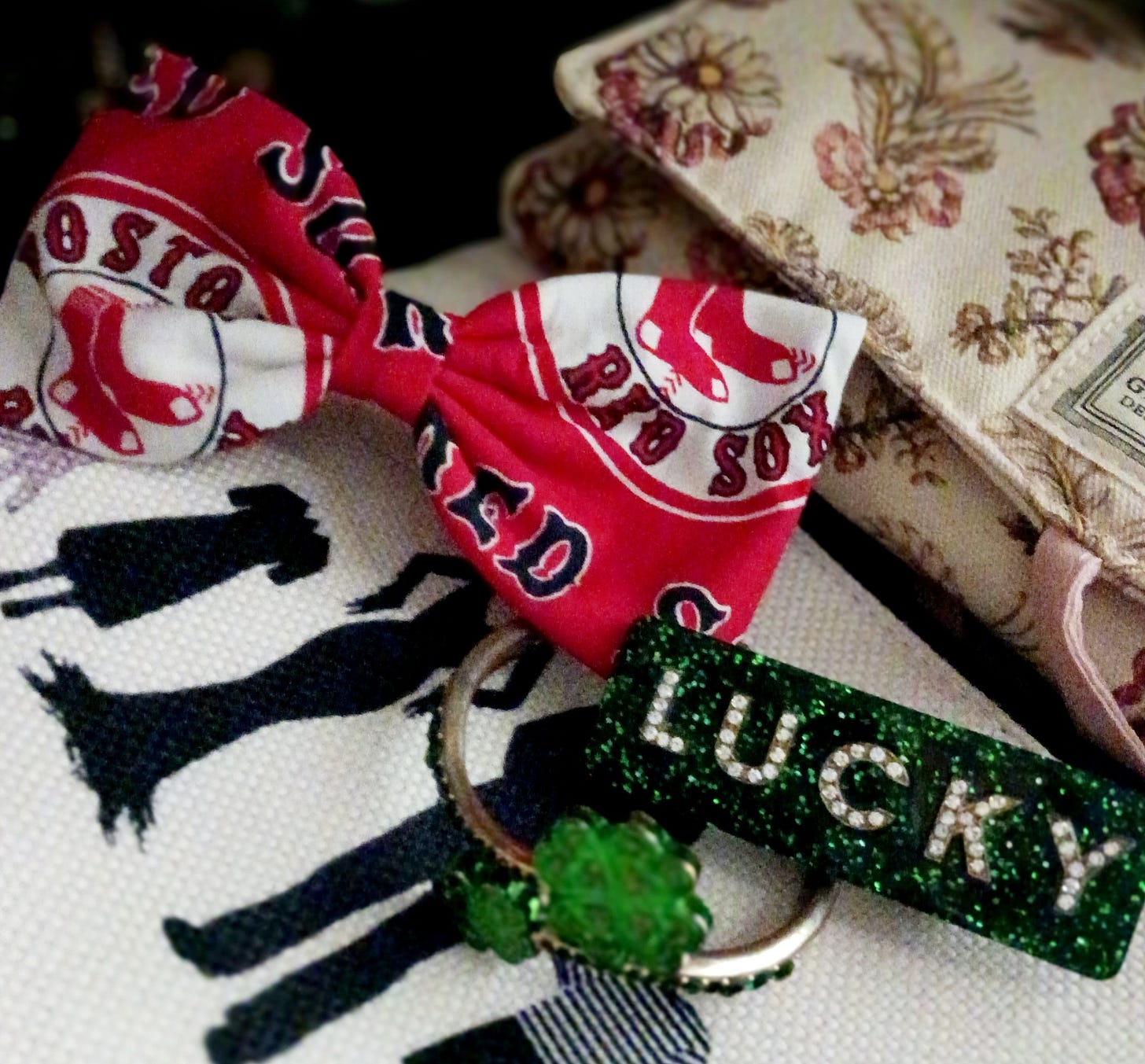
Fellow baseball-junkie (Dodgers-devotee, Mookie Betts fan-boy and famed animator and illustrator, Kelly Kennedy (Spongebob Squarepants, Little Golden Books, Highlights Magazine) claims a more mellow, yet still superstitious, approach.
I'm not superstitious, but I do feel inclined to wear my team sweatshirt even at home while watching a game if I'm really trying to will the team into winning. If I don't, then it's like my 7th inning prayers won't be heard!
- Kelly Kennedy
Spongeb … I mean, Kelly is correct. Late-innings are bonkers important! Hence the inside-out rally caps, Matt Kemp's scary Rally Monkey, and, perhaps one of Baseball's most honoured rituals, Fenway Park's 8th-inning singing of Neil Diamond's “Sweet Caroline” … bah bah bahhhhh!
If you've only ever participated in a “Sweet Caroline” sing-along at, say, Oktoberfest, that's joyous! 800 crazed Deutschers waving their happy Steins aloft, swaying back and forth? So much fun!
However, “Bah bah bahhhhh!-ing” with 36K crazed Red Sox, and visiting-team, fans in unison and waving your $20 Fastball aloft (the official Fenway cocktail)? That isn't simply joyful or fun; it's exhilirating, almost spiritual. It's, So good! So good! So good!! This baseball-girl highly recommends it.
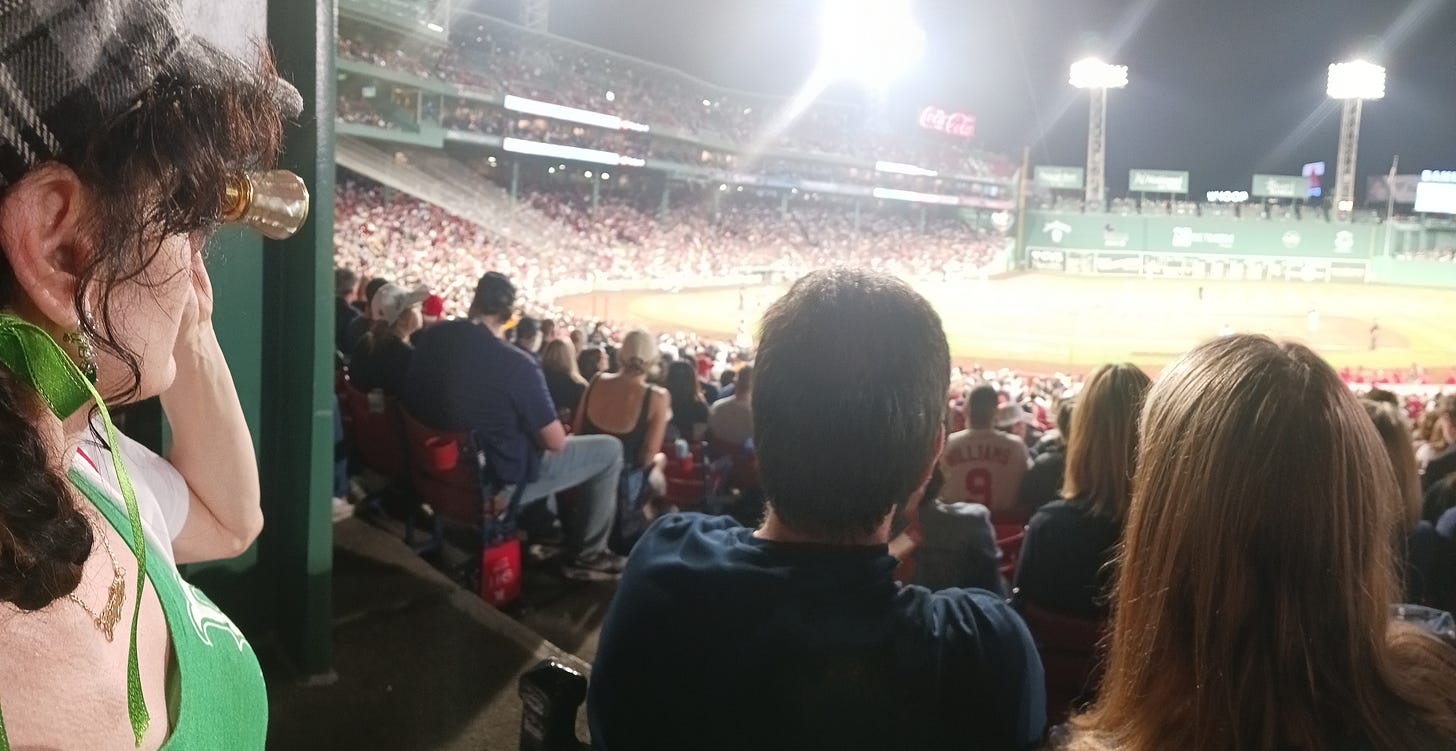
One can't reference stadium singing sans the 7th Inning Stretch sing-along: “Take Me Out to the Ball Game”. The anthem's Major League debut arose during the 4th inning, of Game 4, of the 1934 World Series. (St. Louis Cardinals def. Detroit Lions, 4-3 in seven games).
However, the song was penned a generation previously in 1908 by lyricist Jack Norworth and composer Albert Von Tilzer. Norworth was inspired by a baseball-game advert he noticed whilst riding the subway. Ironically, Tilzer would not attend his first ballgame until twenty years after recording the renowned tune; Norworth wouldn’t attend his first until thirty-two years afterward! This is a clear, double-failure, gentlemen.
To be precise, stadium songs aren't superstitions, so much as rituals. Still, if music directors stopped playing “Take Me Out to the Ball Game”, anywhere, in the 7th, or “Sweet Caroline”, at Fenway, in the 8th, I imagine there'd be a fluster about it. I'd certainly fluster. Of course, I'm known to fluster about many a thing.
Whether it's wearing the same tee or unwashed socks, singing loudly, eating a specific snack, sporting special bling, listening to psych-up music or watching certain shows pre-game, good luck charms and behaviours can help, if it builds confidence and self-empowerment. It's that winning feeling and it can come to fruition.
My own press toward wishful excellence in Irish step-dancing employs just as many quirky beliefs, reliances and Lucky Charms as in any other sport. (Yes, Irish dance is a sport.) For Yours Truly, there's definitely a baseball-belief crossover.
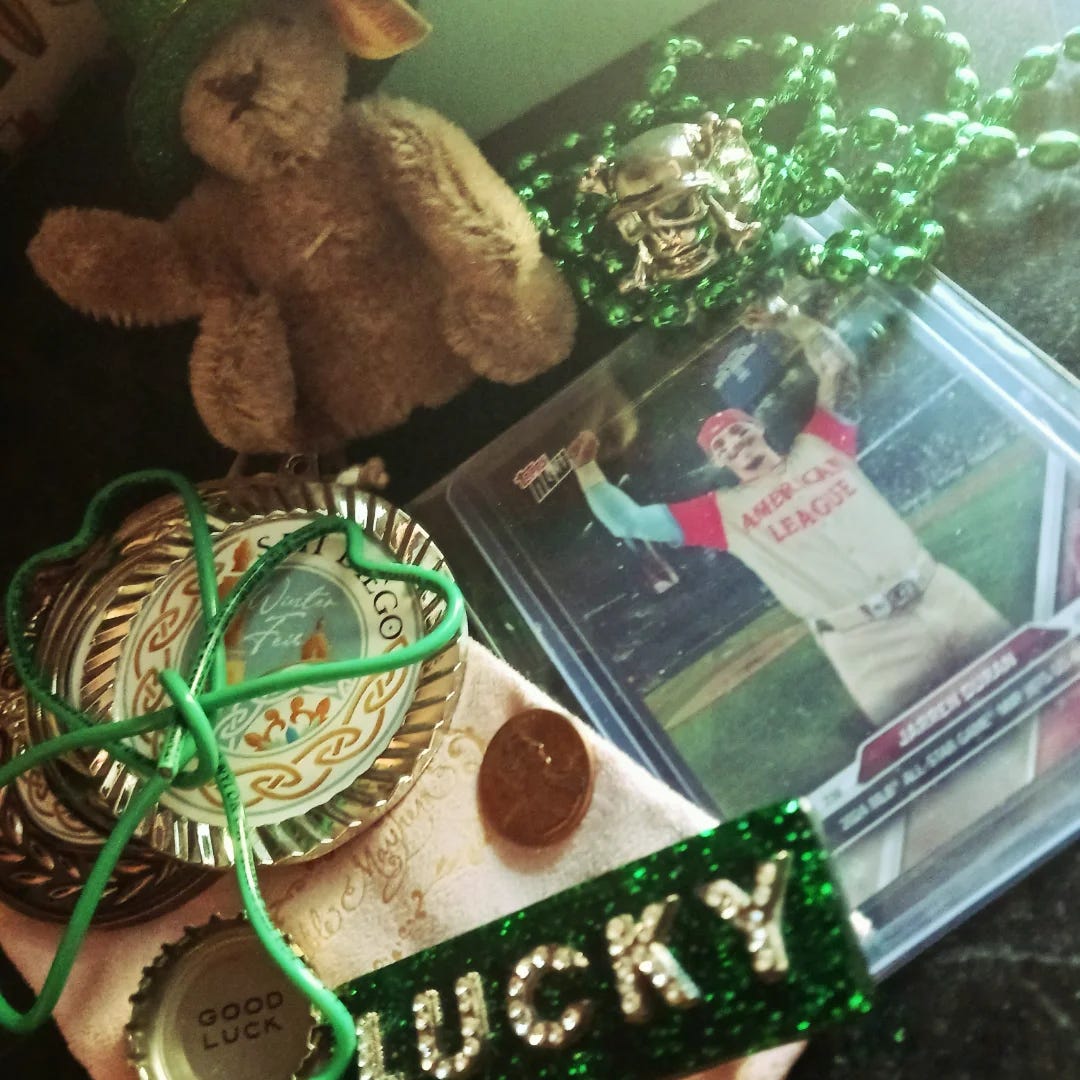
Maybe it's the mystical nature of the Irish landscape and folklore, yet superstition just clicks with Irish dance. Naturally, like with baseball, the athleticism is what matters, mostly. Sans preparation, all the little rituals, charms and psychology are just nonsense taking up time, sentiment and space in your gym bag. I can meditate, present offerings to my Misty Copeland Barbie and rub my old ballet slippers all I want; but, without the lifetime training and talent, I'm never going to be Misty Copeland (American Ballet Theater's female principal dancer).
So, to achieve my own Irish-dance goals (Adult Champs-level; U.S. Regionals; Oireachtas “where the bad-ass dancers go”), it starts with training and discipline on all facets: gym workouts, yoga sessions, nutrition, home dance-practices, classes, listening to my coach (Miss Christine), visualizations, meditations, bites of sports-psychology, journaling, drills, YT tutorials and far too much helpful advice and tips from other dancers online. It also means keeping negative thoughts about my perceived skill, talent and progress at-bay. F*CK ‘EM, right?
After all that, there wait patiently for me, when I'm ready, in my brain and my dance bag, myriad little measures of good luck.
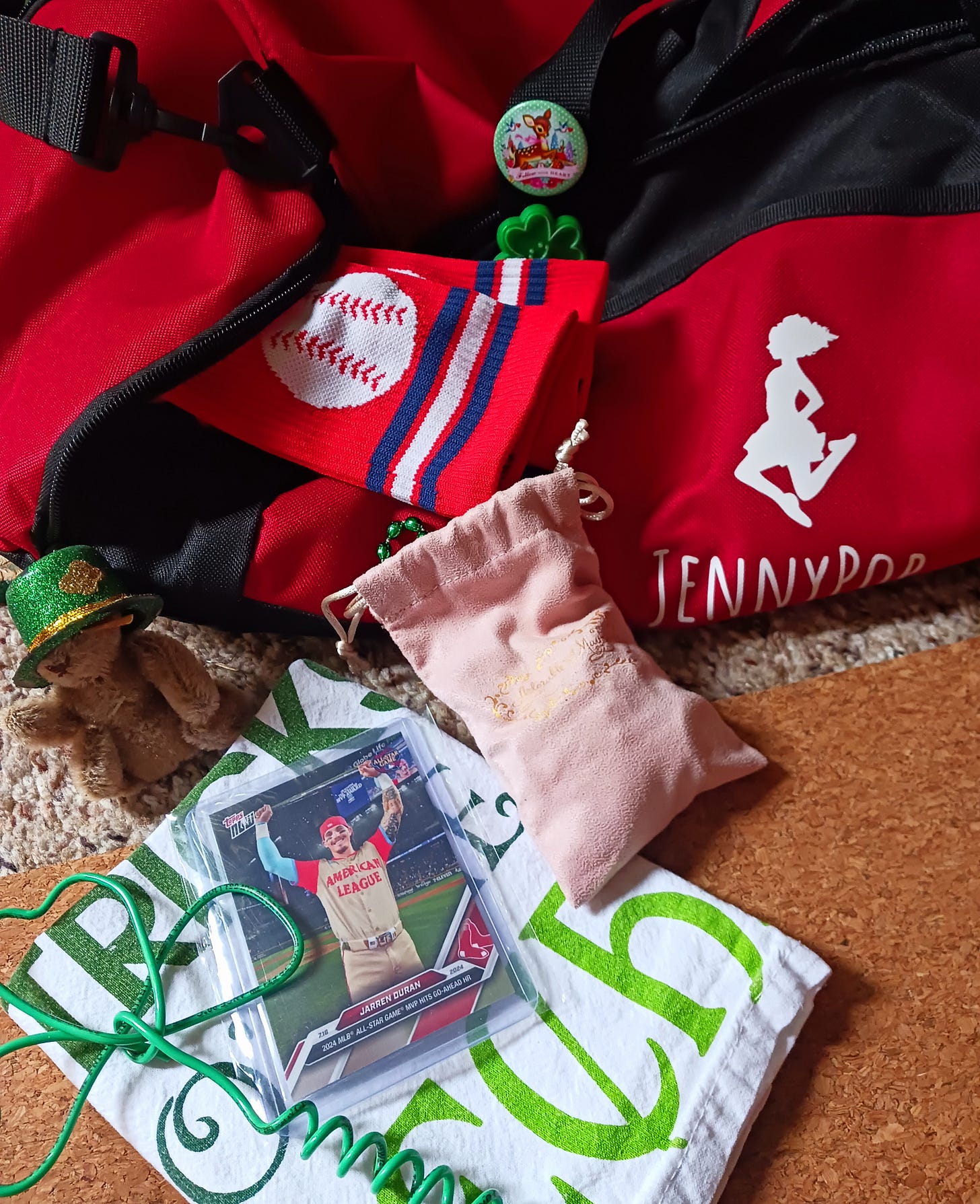
Here are a few more easy lists to save you from those long-winded paragraphs.
JennyPop's good luck dance-charms:
-
My gold, JennyPop necklace
-
My Linda Belcher, tennis socks (dance trick: wearing socks under your black tights, to make your shoes a little snugger)
-
Mommy's teensy, Steiff teddy bear in his teensy, green-glitter top hat, procured from Miss Christine's Prize Bucket
-
A strand of cheap, green beads you get at any bar on St. Patrick's Day, given to me by my "step-sister" (fellow Irish Step-dancing cohort DancyFitz)
-
My "Pretty Girl Award", a shamrock wand handed to me by some drunk dude one St. Patrick's Day at O'Sullivan's Irish Pub
-
My lucky St. Patrick's Day towel
-
My Connemara marble bracelet, a Christmas pressie from my sister-in-law who was there to see me not cry at my very first feis
-
A plastic shamrock I found on the floor of the dance studio (prob overflow from Miss Christine's Prize Bucket)
-
A blingy, Betsey Johnson, shamrock bracelet
-
The first three feis-medals ever earned: two silvers and a bronze at San Diego Winter Feis
-
A lucky penny I found at a feis
-
A cold-brew coffee bottle cap that reads Good Luck! on the underside
-
My official, red, Jarren Duran F*CK ‘EM tee (worn the day, and night's sleep, before a feis; or, if it's a long drive, in the car before changing into my dress)
-
My Jarren Duran All-Star AL/MVP baseball card (well-protected in double-plastic covers)
-
Any one of my Red Sox caps to wear for the ritual, après-feis Guinness, at any nearby Irish pub or sportsbar
-
My “JennyPop #19” official Red Sox baseball jersey: pre-feis/après-feis warm-up/cool-down gear
-
A pirate ring purchsed on a recent trip to Salem, Mass
-
My delicate, silver, Celtic knot bracelet: a Christmas pressie from DancyFitz
-
My unwashed, red, baseball turn-out socks (worn throughout the relentless,10dy-Final Countdown home-practice stretch): also a Christmas pressie from DancyFitz
-
My Tiny Linda Belcher action figure, complete with teensy wine-glass and -bottle … because every dancer needs a cheerleading dance mom … All right, Jenny!!
“You carry all that to feis?!” he suddenly realized, upon reading.
Yes. However, I'm either wearing it, or it fits in a small jewelry pouch, or a pocket in my dance bag or purse. Ot looks like way more than it actually is. I mean, one charm is a penny and another is a bottlecap. At least I'm not taking my Jarren Duran-signed baseball … or my Duran-signed Fenway seat. Although, hmmmm …
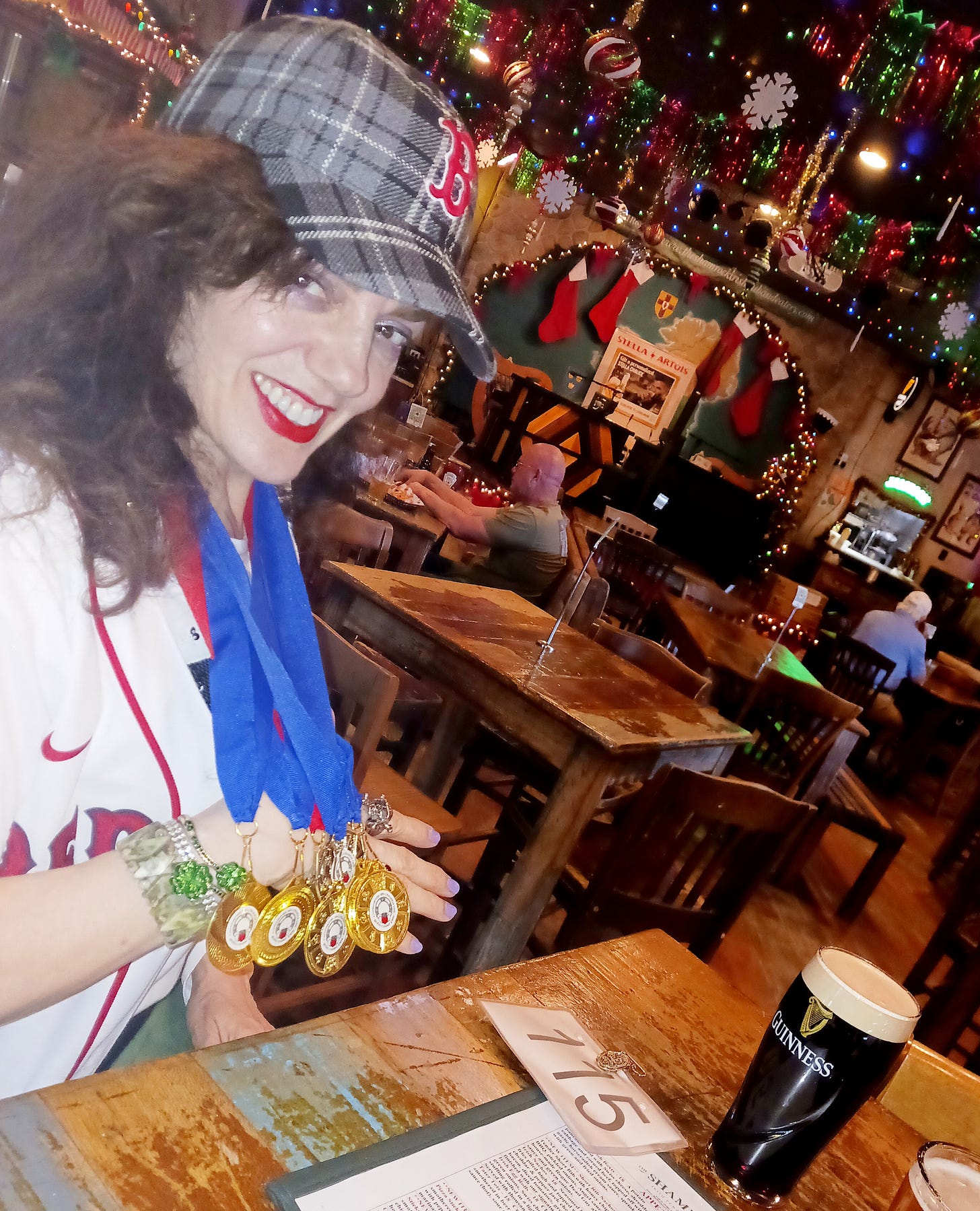
Of course, after all those charms do their best magic, the most important ritual is the après-feis Guinness. Whether it's a celly or a consolation, it must happen.
On Feis Day, besides making sure my good luck charm-bag is safely tucked in my dance bag and I'm wearing all my proper gear and accessories, there's little time for any silliness. It's time to seriously shine. However, there are still a few silly musts:
-
Eating a bowl of Lucky Charms
-
No weighing myself (even a 1.5lb surprise can play w my brain)
-
Only pump-up tuneage in the car, on the drive: hip-hop (Snoop Dogg), Irish pub rock (Dropkick Murphys) or Eminem and mgk
-
No negative talk or talk of future dance
-
Drinking one Sbux “doppio espresso with foam”
-
Eating one Cheez-It per dance (that's seven total)
-
Never say, Good Luck! to another dancer; we say, Have fun! (After all, feis is Irish for festival!)
-
Most importantly, never ever EVER tell me my results until I have completed all my dances … don't do it
-
If there are bad results, “no crying in the car on the way home”, per Miss Christine
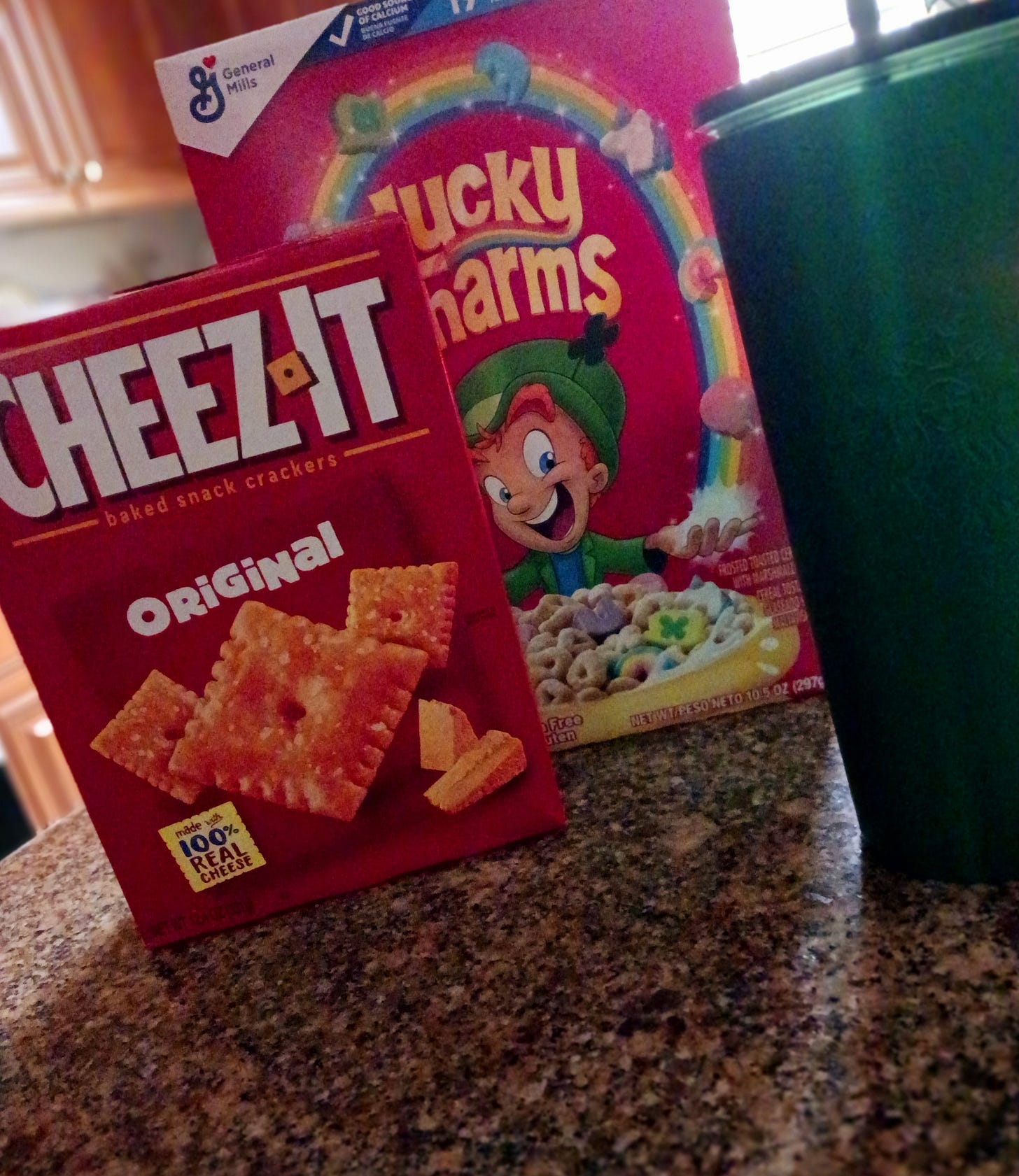
Super prior to a competition, like, the week prior, there are shows I must watch:
-
It's Always Sunny in Philadelphia, all the Ireland eps (S15, e4-8)
-
It's Always Sunny in Philadelphia, “Frank Reynolds' Little Beauties” (S7, e3)
-
It's Always Sunny in Philadelphia, “Charlie Catches a Leprechaun” (S11, e8)
-
Family Guy, “Peter's Two Dads” (S5, e10)
-
Flashdance
-
The Game That Changed Everything: Yankees vs. Red Sox ’04 ALCS
-
30 for 30, “Four Days in October” (S1, e24)
-
Any baseball game or MLB news
Conversely, I cannot, will not, must not watch anything Irish dance-related, like Jig … and so help me, no Riverdance or Lord of the Dance. Whilst this is some of the best dance inspo available, it can be soul-crushing right before a competition.
Aren't superstitions silly, after all? They're simply coping devices to keep our temporal lobes chill so no one gets hurt: that brain bit which regulates all those stupid feeeeeelings and emotion.
Nevertheless, psychologists admit a measured amount of superstition and ritual - in any endeavour - evidently does increase performance, largely by a placebo-like effect of increased confidence. Whitening your teeth, doing your nails, getting highlights and sporting new bling won't actually affect your memory, muscle movement, agility or speed; but, it could affect your overall performance as you hold yourself higher, sturdier and prouder.
The ritualistic oddities of baseball and Irish dance parallel each other because both sports are total head-games.
Baseball is America's Pastime and, if you're fortunate enough to hit the Majors, results can be life-altering (i.e., Juan Soto's Mets contract). It's a very small club, though, and the land is littered with grown men (and some chix) fan-boying (-girling) for the guys with the job they really want.
My father was a lifelong Padres fan and a Babe Ruth (Red Sox years) devotee. He oft stated the three greatest men in history were Socrates, Sigmund Freud and Babe Ruth. He also happened to be an über-educated and noted clinical-psychologist with four degrees and lucrative practices throughout his sixty-year career. Still, within the year he passed, he repeated the strain one day, on a drive along PCH, that he always wanted to play baseball professionally. “I'd give it all up today just to play in the minors,” he claimed. He meant it.
“Some guys have heart, some guys have an arm. I had all the heart, but I didn't have the arm.”
- Dr. Bobo
Irish dance itself has a pretty narrow path with remarkably few options at the top: performing professionally (Riverdance, Celtic Steps, Busch Gardens and some smaller dance companies employing seasonal dancers), or teaching and/or owning a dance academy. Most dancers “age out”, however, in their teens: tiring of the hard-core workouts, weird wigs, heavy dresses and regular travel (not to mention the bonkers-costs associated therewith).
By fifteen or so, many want to move on to, you know, life as a teen: high school, college, dating, other sports, etc. They also probably get tired of questions like, “What's up with your arms? Why do they just hang there?” and, “Why are your wigs so big?”
Adult Irish-dancing is a relatively new occurrence and its popularity is growing. Still, the sport remains predominantly children and adolescents and they're supernaturally good. No bones, I suppose, when we're little.
In the end, good luck charms are important on some level because, honestly, the randomness of even being born proves that luck, serendipity, Fortuna's Wheel, God, whatever/whomever you call it, does play a role in our very existence. Whether it's a 98mph fastball barely missing a batter's head, or a dancer's slick jig-shoe missing a dangerous, stray bobby pin or rhinestone on the stage - or actually falling prey to such accidents - there's an element of luck (good and bad) in everything we do, every day.
“The man who said ‘I'd rather be lucky than good’ saw deeply into life. People are afraid to face how great a part of life is dependent on luck. It's scary to think so much is out of one's control. There are moments in a match when the ball hits the top of the net, and for a split second, it can either go forward or fall back. With a little luck, it goes forward, and you win. Or maybe it doesn't, and you lose.”
- Christopher Wilton, Match Point, written and directed by Woody Allen
May the ball always tip forward for you, Fair Reader … and remember, F*CK ‘EM.

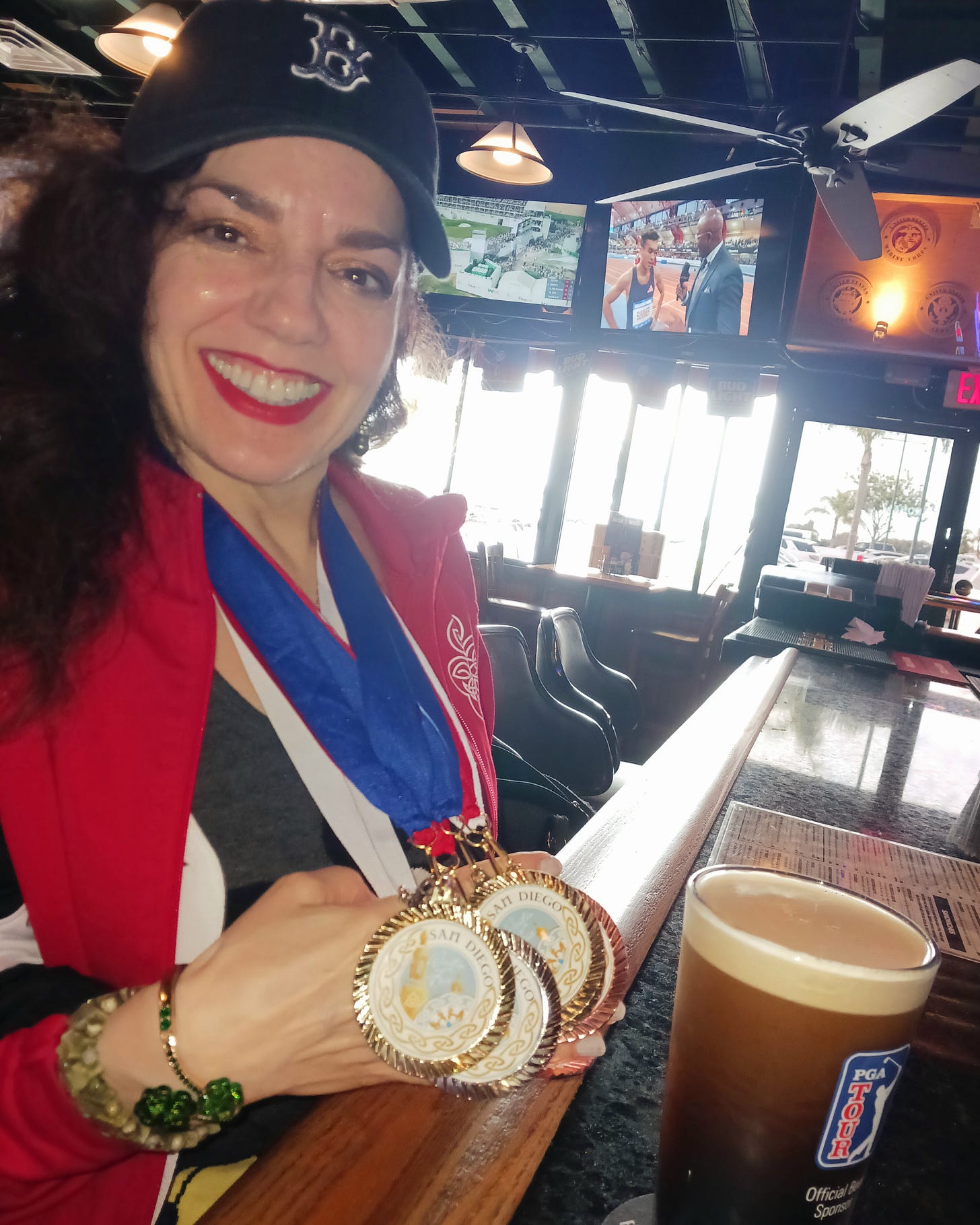
Baseball and Irish-dance seasons are upon us! Baseball's Opening Day is March 27th and St. Patrick's Day is the pinnacle of March Madness (Irish Madness, not Basketball's). Follow @JennyPopCom (IG) and subscribe at jennypop.substack.com for all the #JennyPop/#BostonJen/#CelticJen baseball-y, Irish-y goodness here on Substack, at jennypop.com and on X & IG at JennyPopCom.
Know any fellow baseball (or Irish-dance) freakos? Pls, feel free to share my post with them
Methadone Baseball / JennyPop's Clinic to Surviving the Off-season
Hallowe'en to Valentine's Day: the exact duration from the end of the 2024 World Series (October 30th) to 2025 Pitchers and Catchers Report/Spring Training (February 12th).
For normal humans, that's not too long a stretch. Truthfully, it flies by too quickly. One night, you're partying on Hallowe'en, next day you're drowning in apple cider and planning Thanksgiving fun; then you're Christmas shopping, now drowning in egg nog, singing along to Mariah Carey and watching all the Christmas Vacation and Elf you can possibly bear; suddenly you're deconstructing Xmas décor and listening to anything but Christmas music; then, smash-cut to … looking for a cute V-Day dress.
For baseball-humans though, this proves a nearly unbearable stretch. Clearly, The Holidays soak up a good deal of this period. Still, after those aforementioned, happy, Holiday diversions, Old Man Winter is the last one to leave and he is soooo bo-ring: lingering around the house, making gross noises when he eats, answering questions with grunts, never up for any activity, hates going out, drinks only decaf coffee and refuses to take the hints that it’s all enough already. So, what time's your flight?
As with any houseguest overstaying his welcome, you need some distractions to keep yourself cheerful and sane, you know, so nobody gets hurt. Thankfully, there exist just enough stimuli throughout Winter, like jangling keys for a fussy baby, to keep fussy baseball addicts, like Yours Truly, calm and breathing deeply until Spring Training arrives.
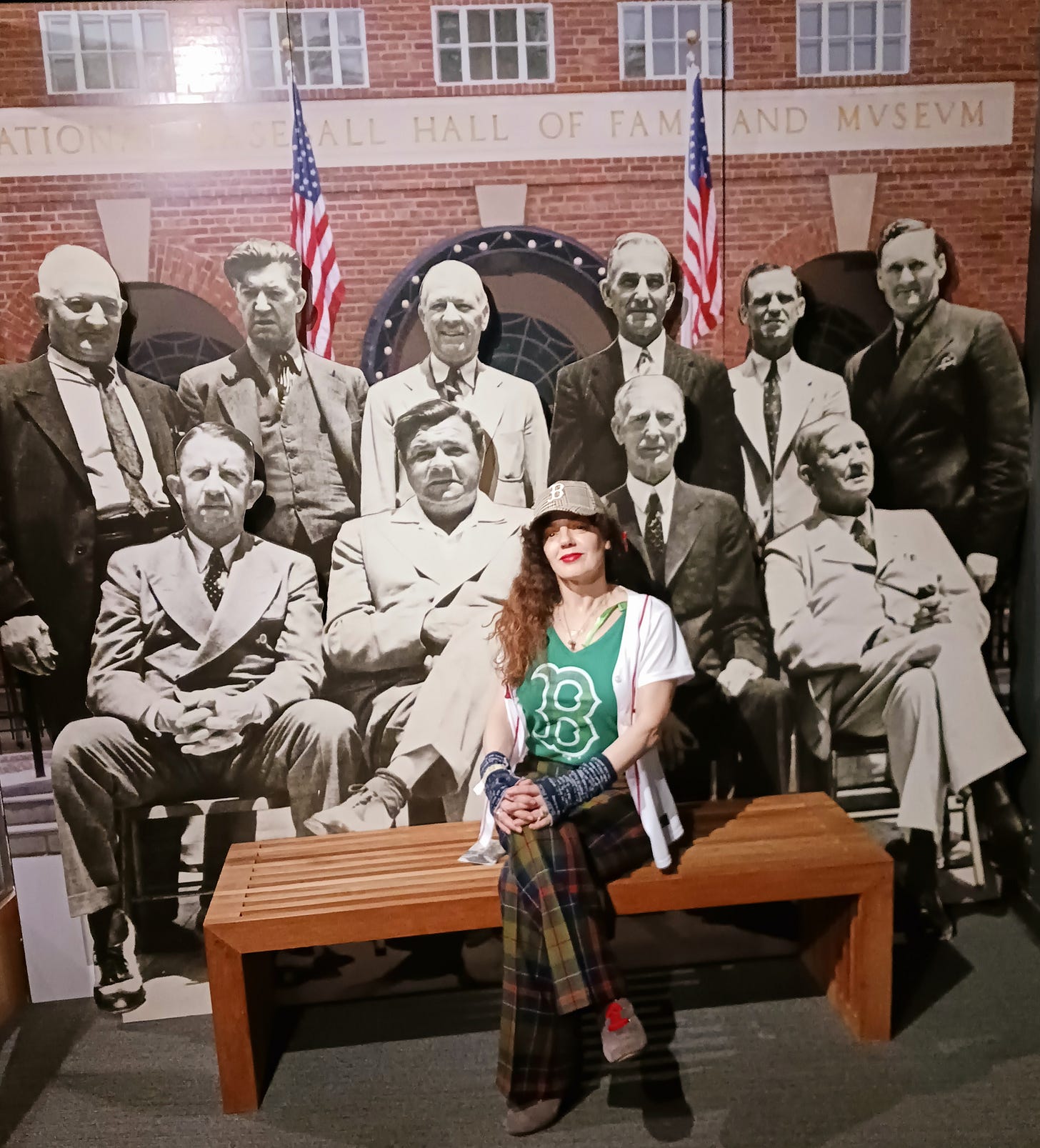
As a snotty teen, I'd observe Dear Old Dad watching old, really old, games in the off-season. Uhh, Dad. You know who wins. This is, like, twenty years old. You know there's loads of other things to watch, right?
He'd simply reply, Pitchers and Catchers Report is coming soon.
Pitchers and Catchers Report, I thought then, was an actual report: player stats and such. It was not until my own obsession with the game - notably transfixing on the Boston Red Sox- did I realize Pitchers & Catchers is not paperwork, but the annual portal to glory. Until that portal opens, though, what's a girl to do?
If I may be so bold as to offer a little assistance, just a taste, to get any fellow baseball-junkies to Spring Training? Like Methadone, I would like to give you some “synthetic” options to help treat your (& my) chronic, baseball addiction. So, follow Moi down the rabbit hole as we learn how best to cope.
*Note: This is primarily tailored to the baseball-centric sports fan. I mean, if you like football, hockey, golf, whatever, you're fine. I do like golf; but that's not cutting it, not even (or, especially not) the new TGL/Boston Common Golf league play.
So, merchandise helps. A girl can never have too many RS caps and cute tees. After all, different seasons, events and fits call for a variety of colours, styles and patterns. It's silly, but, it helps one feel closer to the season/city/team.
Apropos of shopping, discovering the world of baseball collectibles can be a remarkably immersive expedition. As the proud owner of a new, Jarren Duran-signed baseball and an authentic, red Fenway seat, also signed by Duran (#16 OF Boston Red Sox), I can attest there are hours of obsessive joy just waiting for the right nutter.

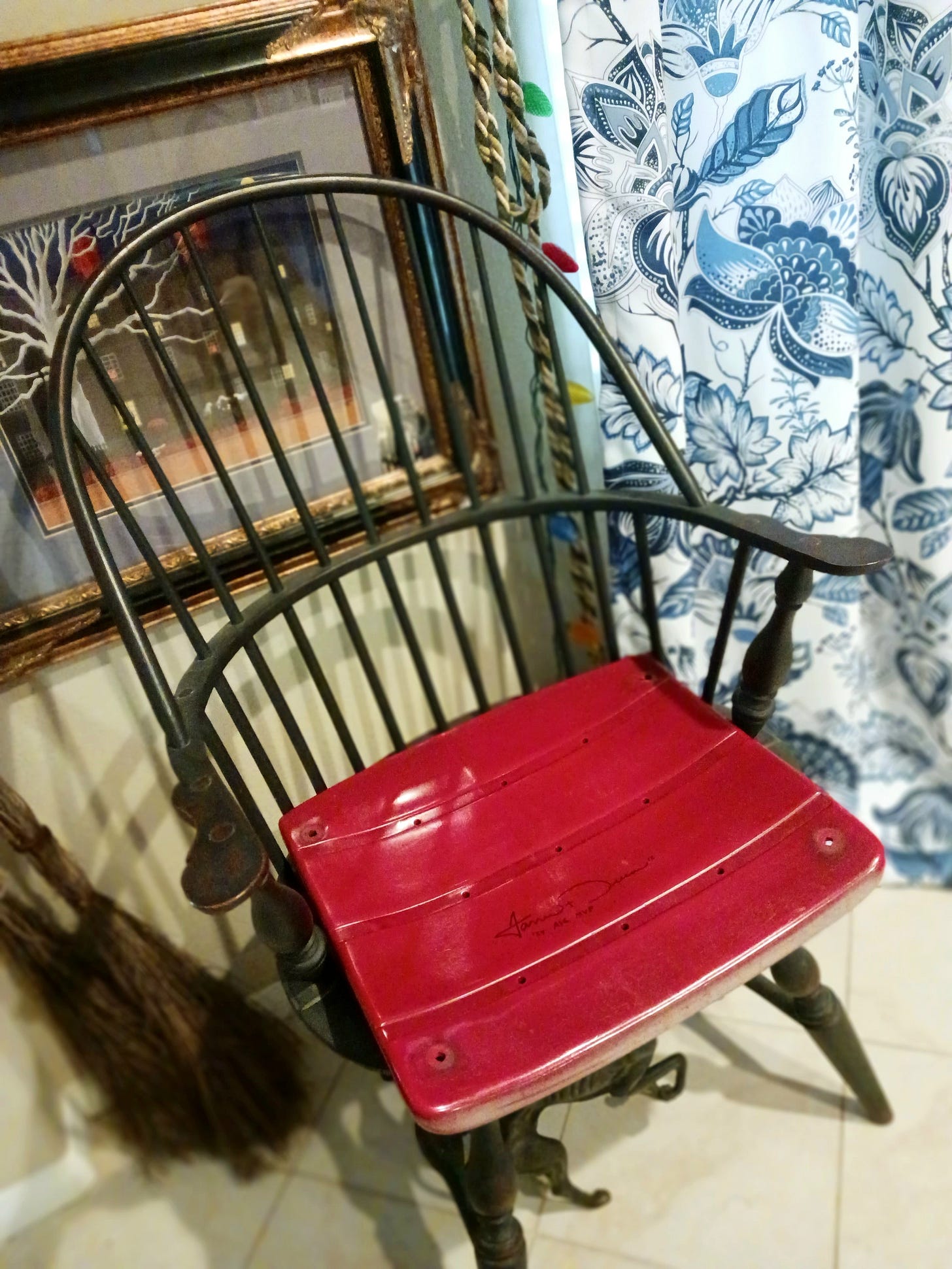

Podcasts help, like Section10: a well-connected, deeply-informative, raucous convo on all-things Red Sox, from player interviews and trade speculations to blue diatribes on club management and Boston sports gossip.
Baseball-writers keep the eyes alert and darting. To paraphrase George Will in the 2010 introduction of his book, “Men at Work: The Craft of Baseball”, I have an “unslakable thirst,” not simply for “writings about the game," but also writing about the game.
There are so many wonderful writings on all aspects of the game: from management logistics to League standings; from current Farm League stats to the history of the game; from last season's heartbreaking fails to next season's potential victories. Sarah Langs, Ian Browne, Alex Speier, Katie Manganelli, George Will and Joel Sherman are all worthy reads. If you're a writer (esp an aspiring baseball-writer, comme Moi), penning about the game is beyond rewarding.
Baseball films are aplenty to get one through the off-season. As well, for this Red Sox girl, any film shot at Fenway Park and/or in any of Moi's fave, adjacent bars (i.e. Cask & Flagon, Game On, The Bleacher Bar) serves my needs exceptionally well.
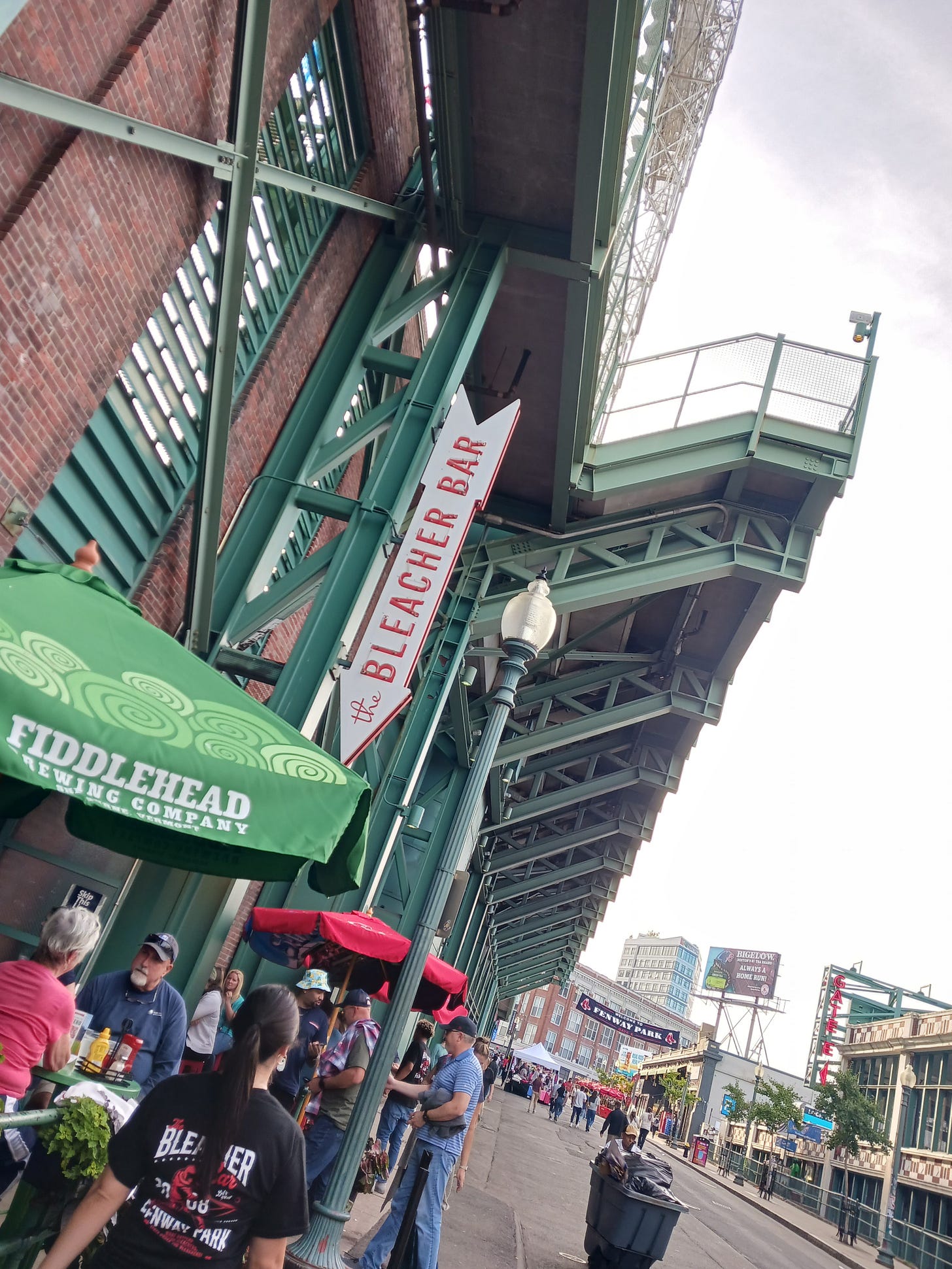
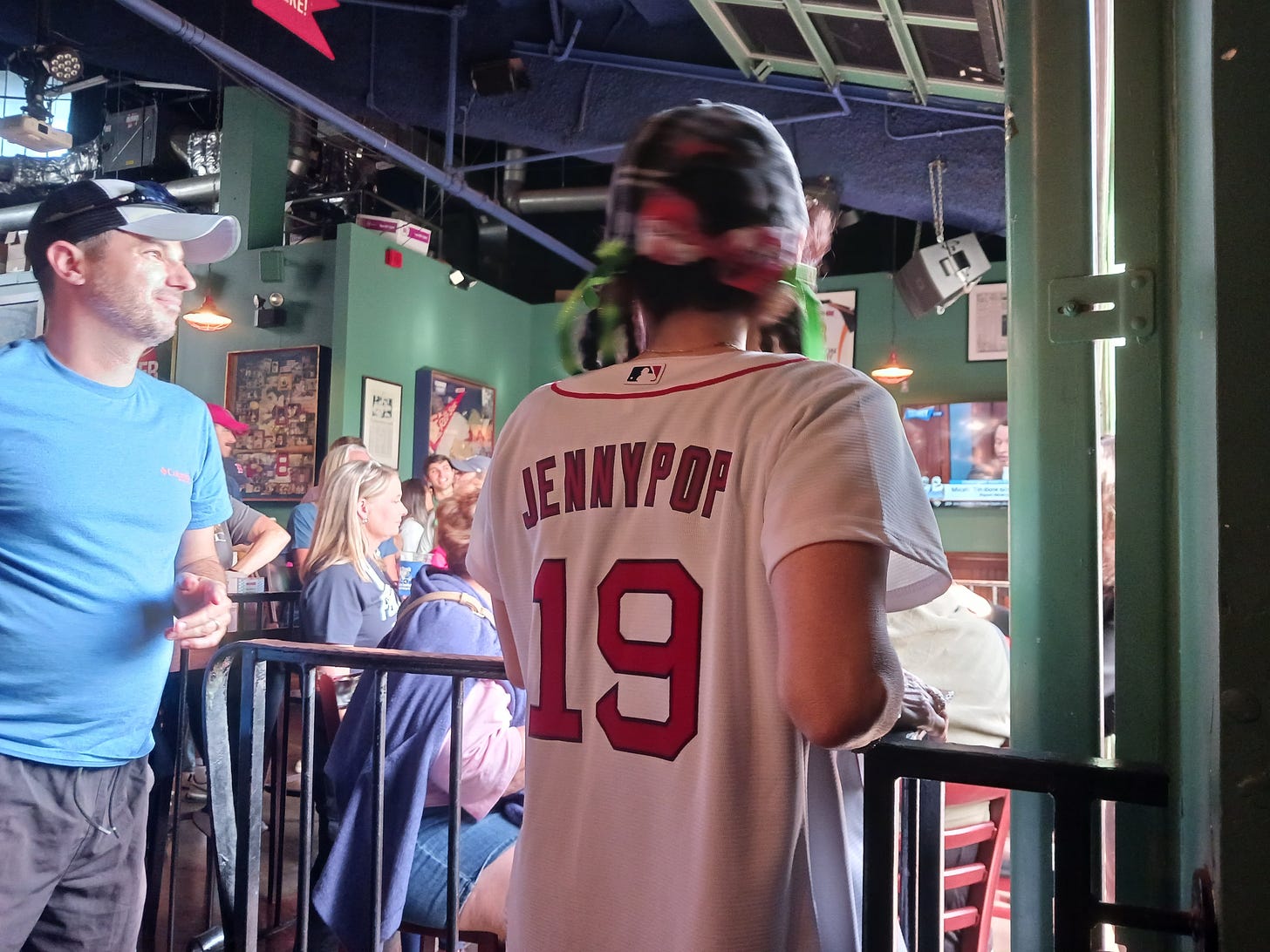
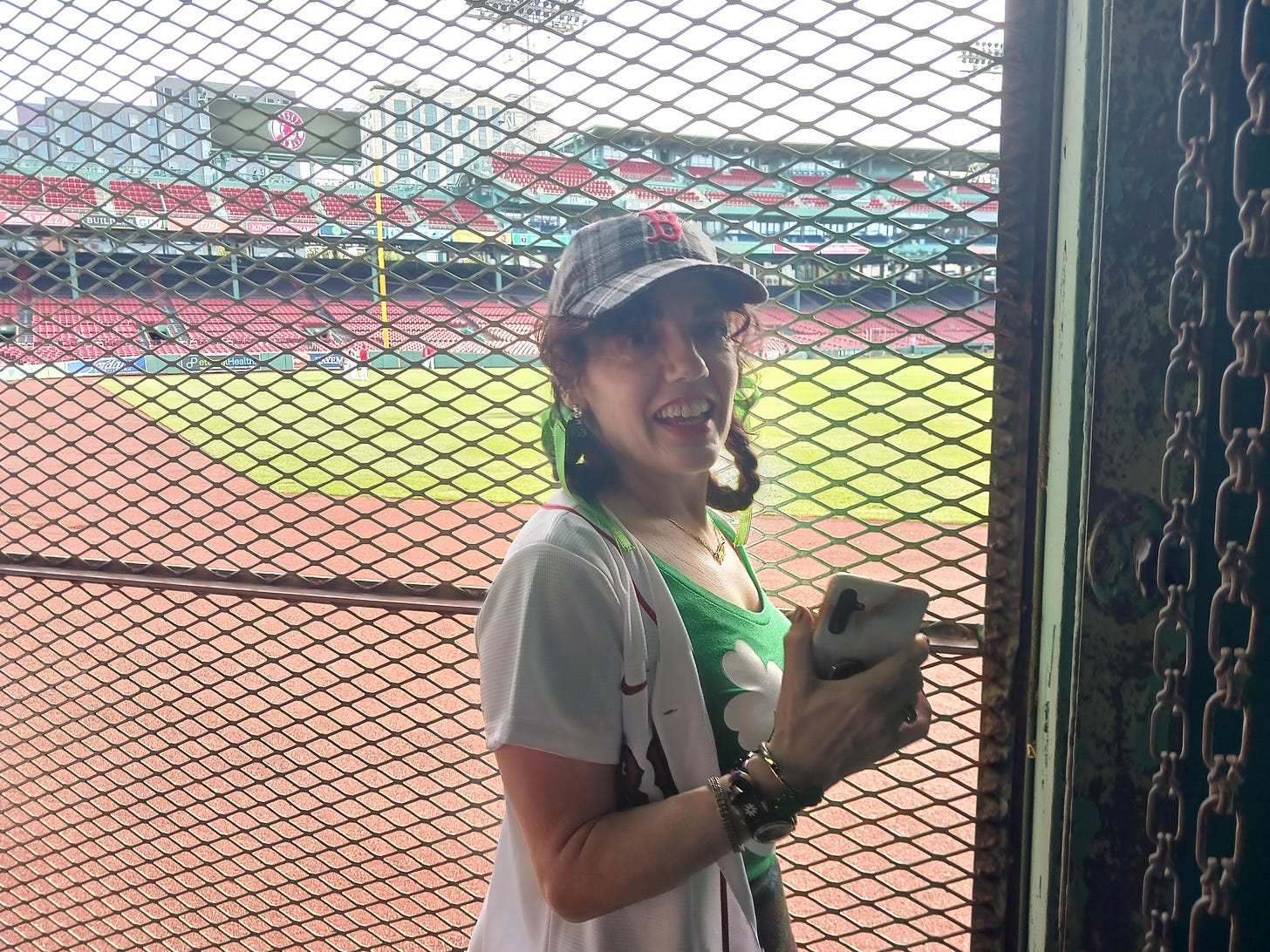
Learning to keep score? This is a challenging endeavour and quite time-consuming, but so fun! It's not simply counting runs with strike-marks; it's bonkers more intricate. A well-filled scorecard should give such a detailed play-by-play account of a game and every player, that the reader can visualize exactly what transpired. (Yes, there will likely be a post on scorekeeping this season. Still learning.)
Planning attendance to next year's games is an excellent activity: Red Sox @ Angels (x2), Red Sox @ Padres, and Anybody @ Red Sox in September and, of course, October (aka Playoff Season).
Following your fave players on social media is a helpful bridge to every baseball fanatic's pressing queries. Let's just use, say, Jarren Duran (aka Goldenboy) as an example: I wonder what Goldenboy does in the off-season? Or, I wonder what Goldenboy’s off-season workout entails? Or, I wonder if Goldenboy has any signing events or public appearances nearby? Oh, look, he does. Hmm, I suppose I could find the time.
See? Stalki … I mean, studying takes a good part of the off-season.
Now, all the above-mentioned diversions are very satisfying, like candy; but, they're not a meal. A girl can't survive on just Swedish Fish and grape Jolly Ranchers. Thankfully, MLB Network is here with some pretty nutritious substitutions. MLB knows its audience and, as dealing with any addict, doing its best to give us just enough of what we need right now.
MLB's 24hr, off-season programming includes films (known as Bleacher Features), documentaries, interviews and player-retrospectives (MLB Network Presents, Studio 42 with Bob Costas and My Best Game, respectively). There is a persistent airing of Ken Burns’ Baseball (an epic, 10-episode docuseries) and repeats of November's MLB awards shows. There's also on-site coverage of December's Winter meetings (the annual congress of team execs, owners and managers). Oddly, no repeats, that I've seen, of that.
There are replays of the previous year's World Series (2024 NYY/LAD … yea, Doyers!), older World Series and various historic and memorable games, often of the 1970s, ‘80s and ‘90s. For the pleasure of all Red Sox Nation, there are myriad retellings of the magical 2004 Boston Red Sox ALCS and World Series victories. Go, Sox!! (If you're unaware of the greatest playoff-season comeback in sports history, look it up.)
There are replays of All-Star Games: the exhibition, mid-season contest between the American League and the National League. Starting with the previous year (2024 in this case), they broadcast back to, well, I don't know, yet. Currently, I am watching the 2016 All-Star Game as I write: Petco Park, San Diego; top of the 8th, 4-2 AL; Mookie Betts, Xander Bogaerts and David Ortiz (aka Big Papi) repping the Red Sox for the American League.
Need some countdowns? MLB's Top 10 Players Right Now, MLB NetworkCountdown and MLB's Greatest give your mania the appearance of order. How about Top 10 catchers, pitchers, left fielders, center fielders, right fielders, 1B, 2B, 3B, SS, relief pitchers, DH of all time? Top 100 plays of the year? Top 10 longest homeruns? Top 20 Pitching Velocities? Electrifying Moments of 2023? Electrifying Moments of 2024? Top 10 Stats and Oddities? Top All-Star players? Top 10 Bat-flips? Why the heck not? Have you watched a good bat-flip?! It's pretty freaking cool. Nothing hotter than confidence.
Finally, there's always topical, regular programming (Hot Stove, MLB Tonight, MLB Network Breakdown, Play Ball): all atuned to the Winter business of America's Pastime. True, the hosts are really stretching air-time with a lot of contrived hokum: dorky spin-the-choice games, mystery callers, free-agent speculation and players in alternating team-uniform graphics. Regardless, I'm clearly still watching. Junkie is as junkie does.
“In the absence of real, hard news … we're brokering in the speculative today.”
- Matt Vasgerian, Hot Stove, 12 January 2025
This time of year, MLB news and talk shows focus on the most pressing matter-at-hand: transactions. Player-movements, trades, free-agent watching, negotiations and contract chatter fill the cold January air. Most astoundingly this Winter is OF Juan Soto's movement from the New York Yankees to the New York Mets for an historic, behemoth contract of 15yrs/$765M + $75M signing bonus … and a suite. The Yankees offered, to retain him, 16yrs/$760M … no suite.
For reference, prior to Soto's pot o’ gold, Shohei Ohtani (RHP/DH) had broken the record in 2023 with a contract of 10yrs/$700M moving from the Los Angeles Angels of Orange County to the Los Angeles Dodgers. (To be clear, there is no such thing as a Los Angeles anything from Orange County. The Angels are in Orange County, Anaheim, always have been.)
Ohtani opted to defer $680M/$700M over the next ten years: taking only a $2M annual salary and deferring the remaing $68M/yr.
Soto has no deferments … and has a suite.
For further, historical reference, in 1919, Boston Red Sox owner and theatre producer, Harry Frazee, sold Babe Ruth (LHP/OF) to the New York Yankees, for seasons 1919 - 1921, for $100K, payable in four $25K installments, at 6% interest, for a final amount of $108, 375.00: the greatest amount ever paid for a player at that time. Additionally, Frazee negotiated for himself a $300K loan, to produce a musical: “No, No, Nanette”. To-date, no self-respecting Red Sox fan will view this musical in any form. Word.
Most fans have eyes on player-transactions, extensions and contracts as January spans ahead. It can be an axious period, hearing news, speculation and, worst of all, rumours about your fave guys. “Rumours” is a lofty word for gossip, and gossip hurts people. I realize the press must fill in time during Winter. However, please stop speculating one of my fave Red Sox might be traded, even after Craig Breslow (Red Sox’ Chief of Baseball Operations) comes out and addresses a specific rumour and says, we're not shopping [him]. I mean, why would Player-X appear at Fenway Fest, if he weren't sticking around past fifty games this season? So, you know, stop it. (Yes, naivete at work here, I admit.)
*Now, if Breslow lied, I'll have something to say to him, and will apologize to the correspondents.
Pertaining to contract-anxiety, Thursday January 9th was the arbitration deadline for 2025 contracts: meaning players and clubs eligible for arbitration did not come to salary agreements in time. This year, seventeen players are now headed to arbitration hearings between January 27th and Valentine's Day, in St. Petersburg, FL, just ahead of Spring Training. That's five fewer players than last year, and about half of the 2023 record-year, with thirty-three players.
*Full disclosure: Of particular note to Yours Truly, one of those seventeen is Red Sox’ Jarren Duran: the only arbitration-eligible player with whom the RS did not settle by the deadline.

“MLB Trade Rumors (MLBTR) predicted Duran would take home $4.9 million in 2025, and after his MVP-caliber season, he's due for a handsome raise. The outfielder made $760,000 in 2024, and slashed .285/.342/.492 with a .834 OPS, led the league in doubles, tied for the lead in triples and earned his first All-Star nomination.”
- Katie Manganelli, BoSox Injection, 9 Jan 2025
Jarren Duran took Major League Baseball by storm in 2024. He led all batters in both doubles and triples, won All-Star Game Most Valuable Player, and set the tone for the Red Sox all year out of the leadoff spot. He finished with an astonishing 8.7 wins above replacement, third among all outfielders.
Duran's second half had some peaks and valleys, but the numbers looked excellent at the end. He slashed .286/.343/.506, with 21 doubles, four triples, and 10 home runs. He shined the most in the second half of August, at one point leading off four straight games with extra-base hits.
- Jackson Roberts, Sports Illustrated, 30 Sept 2024
“Jarren Duran and the team weren’t able to come to terms on a deal for the 2025 season prior to the arbitration deadline, the Red Sox confirmed late Thursday. Boston and Duran were $500,000 off on their arbitration figure submissions on Thursday. Duran filed a $4 million salary request for the 2025 season while the Red Sox filed a $3.5 million salary for Duran in 2025, The Boston Globe’s Alex Speier reported.”
- Connor Roche, Boston.com, 10 Jan 2025
MVP All-Star Duran started 160/162 of RS games in ’24, with 111 runs, 48 doubles, 14 triples, 21 HR, 75 RBIs and 34 stolen bases.
Do the right thing, Boston. Give Goldenboy what he’s asking. I'll probably end of covering some of that $500K difference, you know, in cute, Duran tees and jerseys.
In general, the baseball world is doing its best for us diamond-junkies. MLB Network is jangling a lot of keys and I'm a relatively happy baby. Podcasters are giving my curiosities and musings the raw catharsis and validation I need: if only to know, that I know what I'm talking about, kind of.
As noted above, all the teams and most players are on social media. It is the simplest, most transparent view of the sport and its workings: official, casual, professional and personal. Cheers for all the interim club-news, charity reports, golf fits, doggo pix (love love LOVE pix of a boy & his dog!) and workout inspo, aka #danceinspo. (An Irish dancer, I am forever gobsmacked by the vertical that Major Leaguers achieve when fielding. Share with me all your Spidernan secrets, boys!)
Everyone's off-season efforts are quite pacifying. Like appeasing a toddler on the verge of tears, pulling down that box of Lucky Charms from the high shelf will stave off an embarrassing, Baby Down moment … for the moment.
As for Methadone options, I must proclaim, simply writing this piece was a great coping mechanism. I hope you feel more calm, too.
Now, I'm off to score my next hit. I believe MLB Network Presents is airing “Mr. Padre” again: a doc on San Diego Padres’ Hall of Famer, Tony Gwynn. Superstar right-fielder, possibly the best player the Padres have ever had (and that's saying a lot when you look at past and present rosters) and namesake of San Diego’s own AleSmith Brewing Company's “.394 San Diego Pale Ale”: a deee-lish tribute to America's Finest City and Gwynn's career-high batting average, achieved in 1994. It's a damn fine beer and a damn fine city.
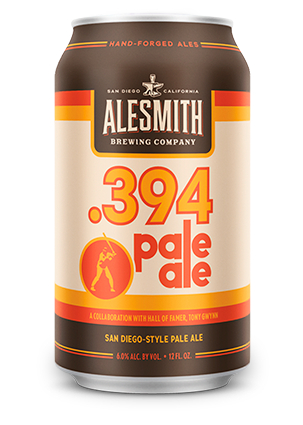
“San Diego. Drink it in. It always goes down smooth.”
- Ron Burgundy, Anchorman
Only thirty-two days to Pitchers and Catchers Report 2025 …
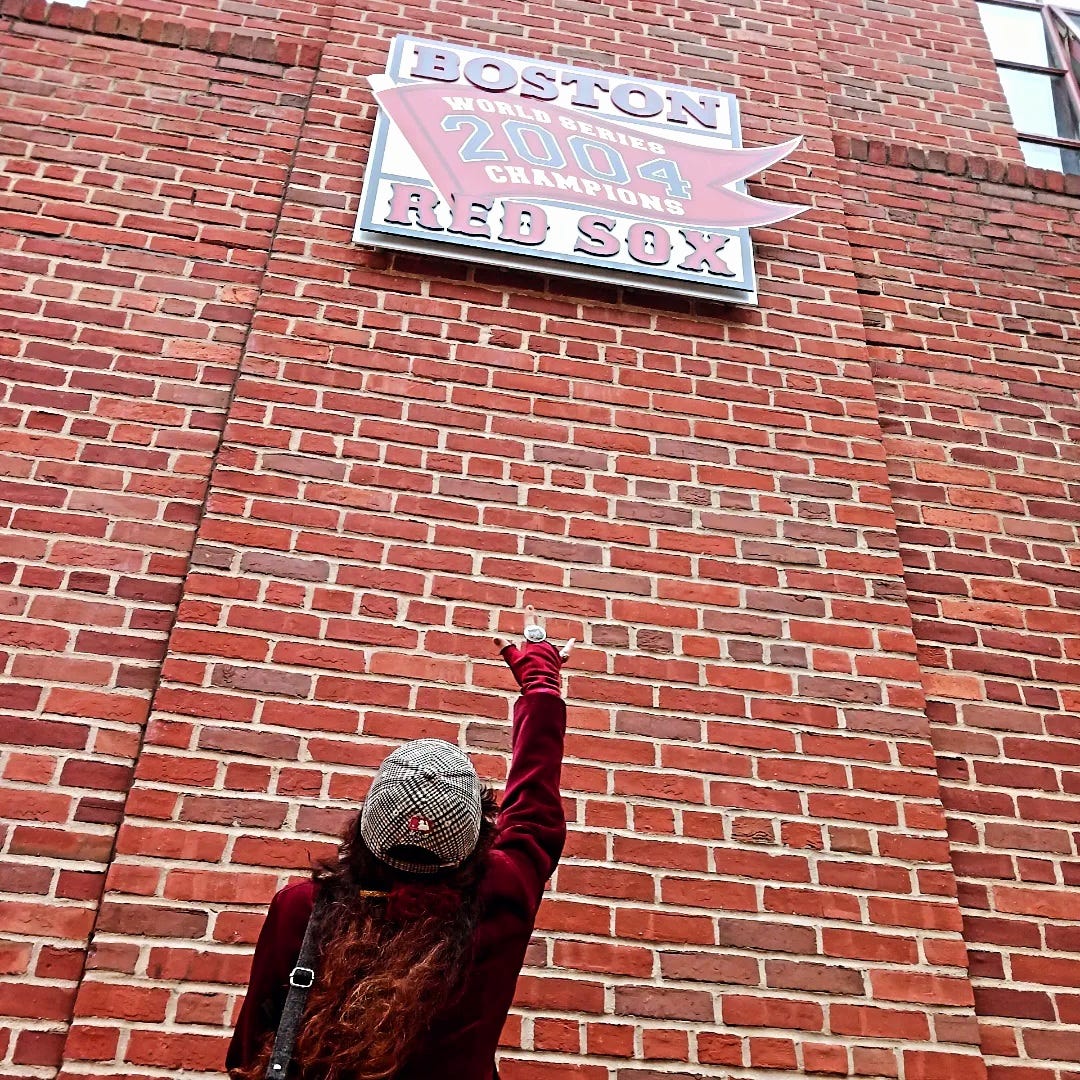
JennyPop's Top 20+ Baseball Films
(In no particular order … excepting the top five)
-
Fever Pitch
-
Moneyball
-
Ted (not a baseball film, but an xlnt Fenway film)
-
The Game That Changed Everything: Yankees vs. Red Sox ‘04 ALCS
-
Ken Burns’ Baseball (10-ep docuseries)
-
61*
-
Eight Men Out
-
Ferrell Takes the Field
-
Major League
-
Major League II
-
The Bad News Bears
-
A League of Their Own
-
Trouble with the Curve
-
The Sandlot
-
The League
-
No-No: A Dockumentary
-
Field of Dreams
-
The Comback: 2004 Boston Red Sox (3-ep Netflix doc)
-
Bull Durham
-
The Natural
-
42
-
The Clubhouse: A Year with the Red Sox (release date: 8 April 2025 … but, of course, you know it will make my list: sneak peek!)
JennyPop's Top 5 Baseball Books (thus far)
-
“Men at Work: The Craft of Baseball” by George Will
-
“Summer of ‘49: The Classic Chronicle of Baseball's Most Magnificent Season as Seen Through the Yankees-Red Six Rivalry” by David Halberstam
-
“Baseball” by George Vecsey
-
“Baseball Field Guide” by Don Formosa and Paul Hamburger
-
“Story of the Red Sox” ed. by The Boston Globe
Did I forget anything? I'm no baseball expert, for sure! (Although, I can dream.) LMK your fave films, books, players, teams, seasons, games, etc. Help me learn more and more and more, kittens!
Follow Moi @JennyPopCom (IG) or on Substack for all the year-round baseball fun you need: plus, loads of other topics like cocktail recipes, style and fashion, media, pop-culture, rando poetry, Irish dance, Irish pubs, Irish travel … well, I am an Irish dancer and St. Patrick's Day is only sixty-five days away, after all. Sláinte!!
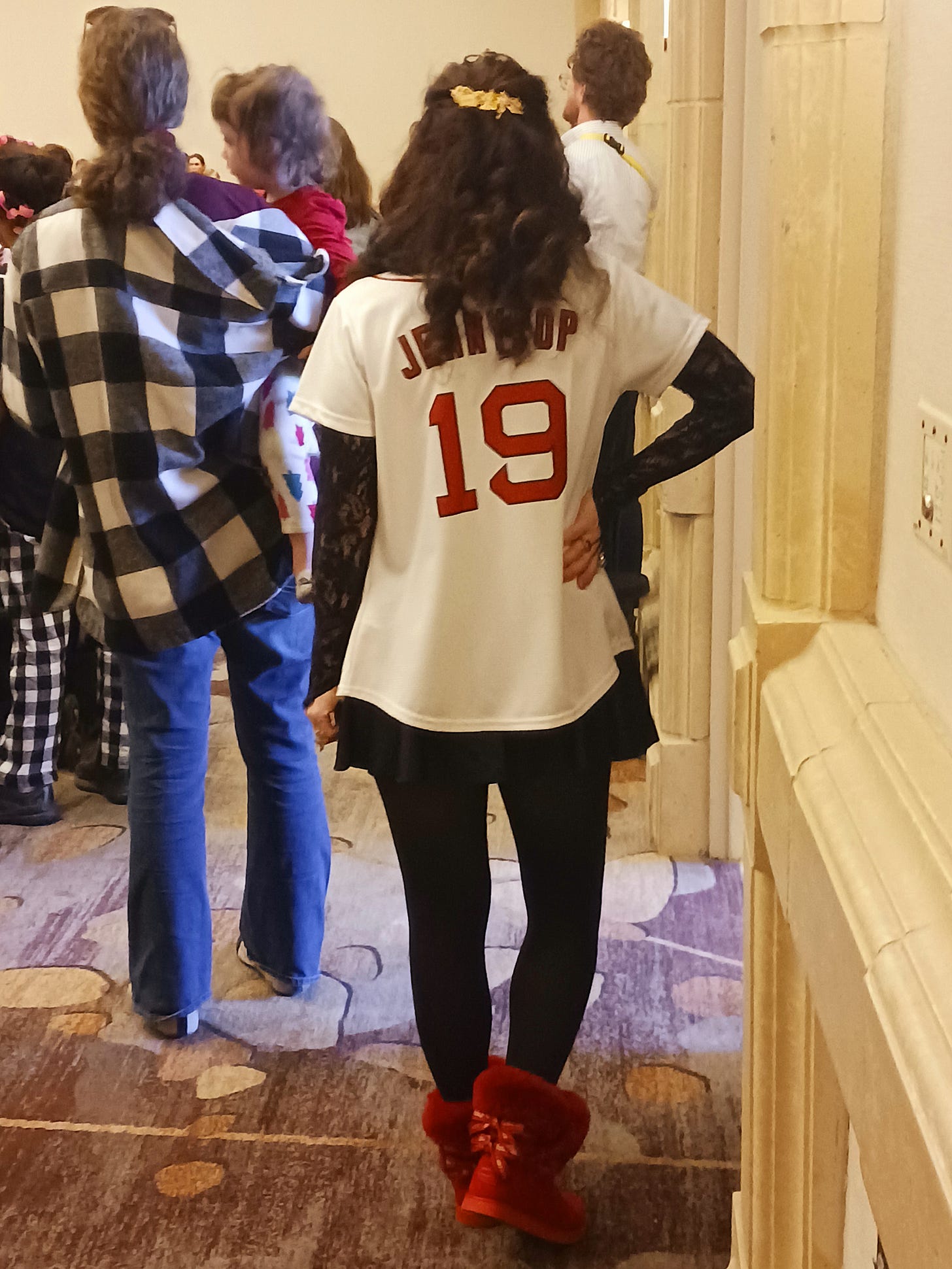
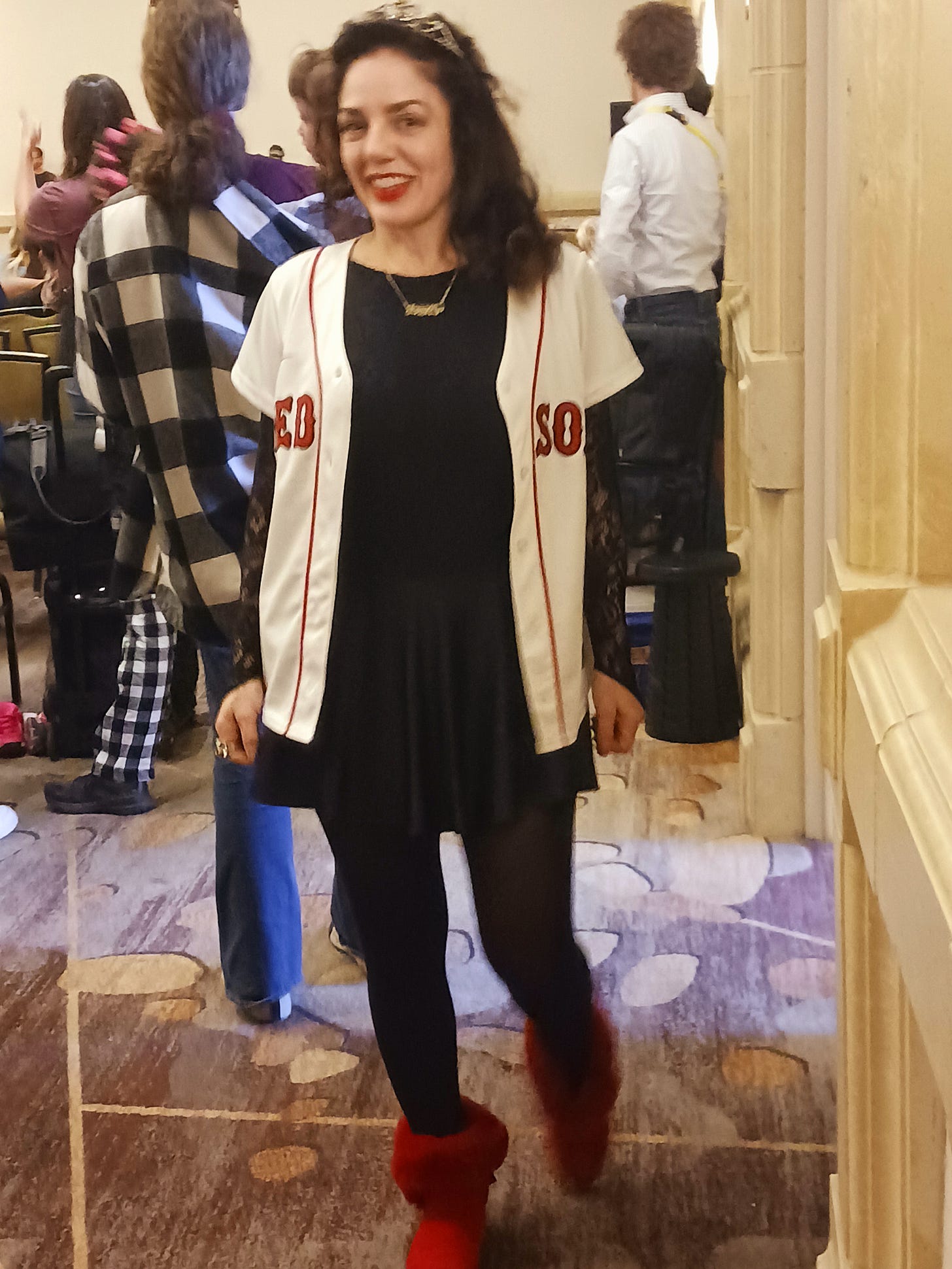
See you at the ballpark, on the dancefloor or in the pub, kittens! Go, Sox!
BTW, I'm a Red Sox Fan Now: Part I "Oh, please. You don't even know what that means."
A Hard-hitting Intro to the Game
Square in the right eye. That's where the pitch hit me. (I'm a lefty-batter; so, the right profile got the brunt.) Third-grade, maybe fourth-, I don't recall. What I do recall is crying a lot, then my softball coach telling me to lie down on the bench and hold a glass of iced tea on my throbbing eye.
The only thing worse than the pain, was the humiliation: lying there like a weirdo with a glass of Nestea on my face. Shaking it off pretty quickly - pride overriding pain - I went right back into play, heading to my position, somewhere in the outfield: excellent placement for me, as getting nailed by an underhanded pitch was my best performance ever, on a baseball diamond.
Softball wasn't really for me. Dance and violin were my things. I liked the activity and energy of softball; yet, the uniforms and lack of glitter left me wanting. Ballet, gymnastics and Polynesian dance pulled hard focus at that age. For this eight-year-old, there was no contest between the fantasy of tutus, rainbow leotards and Tahitian skirts, and prosaic polyester knickers and a t-shirt. Bo-ring.
Fortunately for softball, it lost its worst player the day it gave me a black eye. Wait a minute. Was it personal? Did it edge me out with force? In truth, I was bound to quit the sport eventually. Softball just wasn't jazzy enough for the likes of Moi.
My dad seemed disappointed I quit; baseball was an overriding joy for him. He was rather pleased, nay, surprised, I'd made the team at all. I suspect, though, like when I kicked karate (boring outfits, also), one less extracurricular activity and its ensuing expenses had to please him. No matter, there was enough baseball out there for him, even if I didn't play.
Aside: It turns out none of my childhood pursuits would be a match for the sport where I finally did land: Irish step-dancing. Excess makeup, over-the-top bling and Shirley Temple curls?! Yes, please!
Baseball Zen
What I didn't appreciate at the time, about softball/baseball, was the leisurely practice of it: the blue skies, green grass and birds and little critters on the field. What is lovelier than a halted game, dozens of grown men standing about waiting, leaning on their bats and chatting with other players, whilst the whole stadium waits for a lone bunny, or a pair of doves, to clear the field? That, and when opposing players shake hands, hug or pat each other's butts, makes me really happy. The outfield bro-hugs? Just perfection.
Tina Belcher: “I never realized baseball had so much butt touching.”
Louise Belcher: “That’s how they communicate, Tina. It’s like Braille, but with butts.”
- Bob’s Burgers, “Torpedo” (S1,ep13)
All of this Summer serenity was there for the taking … until those explosive spurts of speed and inertia. A body at rest stays at rest, until affected by an outside force: in this case, a bat, another player, or a ball to the right eye.
Baseball is a game of mellow excitement. Maybe that was the draw for Dad. He was a quiet man, a listener. In fact, he was/still is a renowned, clinical and forensic, child and adolescent psychologist, on both coasts: reigning champ of all quiet, listening professions!
“What do you think it means?”
Baseball is a game wherein one can sporadically sit in silence, with little noise but the scritching of a pencil on a stats notebook, maybe the persistent “Let's go, _____!” chant from an excitable child on the Upper Deck, or the distant call of a concessions vendor. Depending on where you're sitting, you might hear the measured rhythm of a groundskeeper's rake or practice pitches, and subsequent catches, in the bullpen.
In the universe of sports, it is relatively chill, akin to golf. Lots of leaning back, folded arms and brief chats with other players on the field or in the dugout … until there's that satisfying crack of a bat, the rip of a fastball and the spontaneous cheers of half a stadium, intermingled with the excited voices of the announcers in the press box. If it's a homerun, there's organ music! Nothing bad happens when organ music plays, except maybe vampires rising from their coffins as the moon rises.
In the stands, there's always enough down-time for friendly conversations, or light-hearted arguments. Sometimes, it’s sweet, baseball-movie charm, like Kiss-cams or cutie-cute Drew Barrymore in the Farrelly Brothers’ Fever Pitch. Sometimes, it's drunky-drunks blasted on grain-alcohol riot-juice and picking fights with the mascot. Hopefully, those folk are far from your seats and tire out quickly.
“Whenever there's a potential riot, I'm getting blasted on grain alcohol!”
- Mac, It's Always Sunny in Philadelphia, “The World Series Defense” (S5, ep6)
Most stadium experiences are, hopefully, a good memory. Folks just want to enjoy a pleasurable game-day and dream big for their team. A childhood friend started a lifetime of love at Dodger Stadium. There she was on the Jumbotron: all long, blonde hair, cheery blue-eyes, and her wide, brilliant smile. Her husband-to-be saw her, found her and that was it. Baseball is love, sometimes.
Of course, even though there is time for convo, laughter, love and selfies in the stands, for the most serious of fans, that time is spent checking stats, surveying the field and eagle-eyeing all player movements. That fan was Dad, oblivious to all but the theater of the game.
pic
Do Not Disturb
Today, Major League games tend to run approximately two-and-a-half hours. Pitch-clocks, a timer ensuring pitchers deliver their pitches within a :15-:30 time-frame, depending on how many runners on-base, has shortened games a bit in recent years. Batters and catchers have similar time-restraints today. Games used to run longer, a lot longer, or at least it seemed that way, as a kid. I want to say, four or five hours, but that sounds wrong.
Hours and hours, Dad could spend at a game: overtime, extra innings and, wonders-of-wonders, the double-header (two games back-to-back). Heaven! Even sitting in the parking lot, inching his way out to the main road, was joyful.
In a planetary event, sometime in the 1980s, Mom's worst day and Dad's best day aligned when a San Diego Padres game went into extra innings … twenty-one innings in all. Pleading to leave was useless. Dad was pliable, malleable and patient to a fault, but not where baseball was concerned. “Thank goodness I brought my knitting,” was Mom's only relief. She talked about that “nightmare” for the rest of her life.
There was little difference at home: hours and hours on weekends, sitting in his leather club-chair, often falling asleep, watching any game televised. Two-way conversation was generally futile. Mom or I could chatter on any topic, uninterrupted, for minutes on-end, only to finally demand a response of some kind.
“An ‘ugh’ will do”, mom would exasperate.
Ugh, he would dutifully respond.
I learned then, baseball was a great time to ask for things. Ugh doesn't mean, no.
If he drifted to sleep whilst watching, and we tried to change the channel to, say, “Designing Women” he would suddenly awake and groggily say, “I was watching that.”
Mom said, he needed a hotel “Do Not Disturb” sign to hang around his neck during baseball season.
If he had to be out of the house during a game, sports radio was a faithful companion. Their faces weren't so familiar, but the voices of play-by-play announcers like Vin Scully, Bob Uecker and Dick Engberg were so familiar, it's as though they shared the backseat with my Hello Kitty backpack and me.
In October, after he'd exhausted all World Series analysis, pontification and coverage, he'd watch old games on ESPN. I didn't get it.
“You know who wins,” I'd judge.
“It doesn't matter,” he'd reply simply.
Pitchers and Catchers Report
By New Year’s, he'd start making his annual, happy observation: “Pitchers and Catchers Report” is coming, meaning the date the first wave of players, pitchers and catchers, report for Spring Training. Like a parrot, he would repeat it at regular intervals throughout Winter.
“Pitchers and Catchers Report. Pitchers and Catchers Report. Pitchers and Catchers Report. Squawk!”
When he wasn't working, watching baseball, doing yard work, helping Mom redecorate the house or taking us to Disneyland, or South Coast Plaza, he was reading.
Reading material fell into five categories: psychological books and journals; western novels; American Revolution non-fiction; baseball non-fiction; and, above all, The Sporting News.
Never was there a day I didn't see the old, analog, sports newspaper lying somewhere in the house. Even old ones couldn't be tossed until he gave the go-ahead, that he'd read every single word and stat. The Sporting News was where I first saw “Pitchers and Catchers Report” in-print.
Until recently, I'd always presumed it was a report about pitchers and catchers, not that they reported for Spring Training. Who knew “report” was a verb in this case?
pc Babe Ruth
I’d Do It Tomorrow
It was a lifelong obsession, baseball. As a post-WWII child, a Navy brat, Dad played in the streets of Honolulu, Brooklyn, Birmingham, Puerto Rico and, his eventual, permanent hometown of San Diego.
High school, college and the Air Force all supplied him fields and opportunities to play. Later, in his professional life, would play on the odd, hospital- or government-team. As much as he cherished his psychological work, he would've traded that professional life in mental health for a professional life in baseball, in a heartbeat.
My husband and he shared an affinity for the game: both playing in elementary school, high school and both lifelong, SoCal-team fans. Both had been young dreamers, fantasizing of the Major League life; and both were utterly disillusioned by the Major League players’ strike of 1994/’95.
During one of their regular, ocean drives down PCH, they chatted casually, whilst listenng to a Padres game, on the life of a minor leaguer: the long road-trips on a team-bus, the low pay, cheap motels, bad sleep, and the cruel elusiveness of the Majors.
My husband assessed,"At this point in my life, seeing how rough that life can be, I don't think I'd do it.”
“Oh, I'd do it tomorrow,” Dad replied without missing a beat.
He oft lamented, he just didn't have the talent. “Some guys have an arm and no heart. I had the heart, but not enough arm.”
In the 1990s, Rotisserie Fantasy Baseball became an enthusiastic addendum to his passion. The only time he would go to a bar, would be to meet his fellow owners to draft their teams (whatever that means). I'm not sure, yet, but this is likely not for Moi: so many numbers, so much math. Definitely a game of statistics, which he revered.
The last game he ever saw was a Padres home-game. The walk back to the car was longer than he remembered and he was disappointed the Padres lost, again. He carried the glove he brought religiously to every game - in case of fly-balls - and dissected the game with my husband as they walked slowly. Per usual, he channeled his inner-Charlie Brown and found pride in being a “true fan”, regardless of a team's standing. There was a strange honour in having lost, no matter how often. “Anybody can be a Yankees fan,” he'd say. Although, he did love Derek Jeter: Yankees shortstop from 1995 - 2014.
“Have you ever watched Derek Jeter run? He's so elegant, like a gazelle.”
Charlie Brown's everyman approach to life, baseball and dogs was his purest school of philosophy, and he knew his philosophers. Don't blame the sun for getting in your eyes, Lucy. Put on some sunglasses and “do good catching”.
True fans watch, and play, in the rain, they sit behind a pillar if necessary, and nosebleed seats are great because at least you can see the whole field.
True fans never bet against their team and they don't leave a game early “because of traffic”.
True fans are crushed when their team doesn't make it to the playoffs; or, actually worse, makes it, then fails to advance to the World Series.
True fans can still enjoy the playoffs and World Series, even sans their team, rooting for “the better of two evils”; but they never, ever hop on the bandwagon and buy a new baseball hat, “just for the series”.
In their fifty-six-year history, the Padres have made it to the National League playoffs seven times; they've gone to the World Series twice; they lost both of those.
His theory was SoCal players, including San Diego Chargers football (now, L.A. Chargers) rarely win the Big Prize because “the weather's too nice here, life is too easy”. I never thought that made sense, but he believed it.
For comparison …
In their sixty-four-year history, the Angels have made it to the American League playoffs ten times; they've gone to the World Series once, and won.
In their 124-year history, the Red Sox have made it to the American League playoffs twenty-five times; they've gone to the World Series thirteen times; they've won nine times, including enduring an eighty-six-year drought known as The Bambino's Curse, starting in 1919 when the Red Sox traded Babe Ruth (TheBambino) to the New York Yankees.
So, regardless of his team's performance, at the end of each season, Dad would reiterate proudly, “Well, the Padres have been disappointing me for over fifty years. Go, Pods.”
We're Talkin’ Baseball
My parents call the North Shore of Boston home now. The area was an annual holiday destination: Salem at Hallowe'en is addictive, once you've experienced it. Marblehead is simply perfect. Boston-proper is heartening and exhilarating. It is as steeped in history as its harbor was in tea, in 1773. It is, for this writer, the greatest metropolis in this great nation; yet, that's another post.
So, whilst dad was never a Red Sox fan, the town was something very special to our fam. Moreover, as a Babe Ruth devotee, he respected the Sox’ first claim to The Bambino: 1915 - 1919. (Well, after his brief, inaugural stint with the then-minor league Baltimore Orioles in 1914.)
Sure, The Sultan of Swing graced New York's Polo Grounds/Yankee Stadium much longer than he did Boston's Fenway Park: 1920 - 1934, interestingly, the entire stretch of Prohibition, plus one year. Still, for whatever reason, Dad couldn't bear the Yankees. So, he stuck with The Boston Babe.
Now, as the 2024 MLB official season starts, I imagine Mom's once again talking to an open Sporting News as he reads it in his chair, or attempting conversation as he watches the Red Sox, Angels and Padres, by whatever means available, along the peaceful shores of Salem Harbor. Do Not Disturb.
It's As Simple As That
Like truffles in an egg carton, a child growing up with so much baseball in the air is bound to become somewhat infused. There were spurts of interest: the short-lived, childhood softball endeavour; a brief flirtation with softball in college (only to switch to Model U.N. after a professor proclaimed her disgust that I'd “waste time” on a sport); ball-girl tryouts in college; and, a longer, actual flirtation with Single-A ball (minor league): going to games with a friend, hoping the cute players would notice me in the stands.
I say, “me”, because the friend was a dude, btw: my bestie, at the time, and fellow Disneyland cast member. I didn't need another chick pulling focus. Driving out to watch the Palm Springs Angels was good old-fashioned fun and he was an excellent wingman, helping Moi to “pass notes”, as it were. By the end of that season, I only ever talked to one player; he just wasn't that into me. The Desert League then became boring quickly. I don't like the desert anyhoo, no matter how cute the players.
Eventually, as an adult, baseball was of almost no interest: simply something I associated with visiting Mom & Dad, as it was always on, in some form, somewhere in the house.
Ergo, I'm not a complete newbie to the game; but I'm no Rain Man either. Although, I do admit to mild, OCD tendencies and am a bit of a dork. So, if I return here later this season with reports from my new, statistics journal, don't be surprised.
Also, I do have a bro-in-law bordering on savant where baseball is concerned. Moving to the next level of fandom so I can talk to him at fam events and, more importantly, irritate my sis-in-law, might be well worth the deep dive into America's pastime.
Autonomic-loyalties have lain with the Padres and the Angels, as loyalties to Dad, my husband and my hometowns: San Diego and Orange County. (The Angels, btw, - formerly California Angels, then Anaheim Angels - are an Orange County team, not an L.A. team, whatever they call themselves now. Don’t forget it, kittens!)
Anyhoo, like the Pull-Ups commercial sings, I'm a big girl now, still a California girl; but, for ineffable reasons, a Boston Red Sox girl. I've fielded some squinty-eyed queries and good-natured ribbing over it for the last year. It's been hard to explain, because I don't quite know how it hit me so hard and fast.
Maybe it was Dad's passing and his reunion with Mom in Boston. Maybe I'm taking up the relay baton, carrying on his baseball traditions. Maybe it's just damn fun and it helps me feel closer to him. Yeah, it's probably all that, said the shrink's kid with confidence.
So, I don't need to explain it anymore, to anyone. It's as simple as that.
pic good luck t
Well, if it ain't the Queen of Suffolk County
Yeah, best stay out of her way
Yeah, you know she's here to stay
She don't joke and she don't play
She's tough like a tiger
She's all dressed up
She's soft like a kitten
But she'll still mess you up
Here comes the Queen of Suffolk County
Yeah, she's the Queen of Suffolk County- Dropkick Murphys, “Queen of Suffolk County”
pic jennypop jersey
I Get It!
As I learn more about the game, it's virtues and vices, it's heartbeat and history (Thank you, Ken Burns!!), it's intellectualism and it's most uncomplicated joys, I find myself oft turning to my husband and claiming, I get it!
I get it now, all of it: the gentle drone of a televised game on in the background, the greens and blues on the screen, the speculative chatter of sports-radio bros, the annoying sports-shouting at any given moment on ESPN, the search for any documentary available on your team (i.e., “The Game That Changed Everything: Yankees vs Red Sox, ‘04 ALCS”), the need for “just one more Red Sox tee”, the anticipation of Opening Day, the watching through your fingers during Playoff Season, the groans and cheers, the “What do I watch now?” lull of Winter, and, of course, the baited anticipation of “Pitchers and Catchers Report” and Spring Training.
I may not know fully what it means to be a Red Sox fan, but I'm finding out and having a blast doing so. To boot, being the history dork I am, learning allllll about the Red Sox, back to 1901, is sheer Heaven.
“Regret” is not part of the JennyPop patois. Moi is a strong believer in “You are exactly where you are supposed to be.” Regrets are pointless, as the past has passed. However, regrets can be useful to open windows on worlds you may have missed previously.
If I have one of few regrets, it is not taking advantage of baseball time with Dad. I don't know how deep I would delved into the game when he was alive, but I know now, I would've enjoyed sharing inside-baseball factoids with him, maybe even tracking stats. That is still to be determined …
One postseason afternoon in 2023, I found myself standing directly in front of the TV, hands behind my back, watching a Red Sox game. It hit me, at that moment, that's exactly what Dad would do. I always wondered why he stood there, frozen it seemed, so often.
Commenting on the realization, I asked my husband, “What is this? Why did he do this? Why am I standing here like him? So weird.”
“It's called hope,” he concisely concluded.
Dear Old Dad would be thrilled I'm finally paying really close attention. He’d be slightly disappointed I'm not a Padres fan. Yet, he'd be relieved, at least, I'm not a Yankees fan. Ha!
About two weeks before he passed, he and my husband were on one of their PCH drives. The Beatles were playing on Sirius: Dad's fave band for his lifetime. He didn't recognize the music at all, but commented only, “They're okay.” Keeping the curious conversation going, my husband then switched to MLB Radio, to talk about the Padres. Dad didn't know who they were either.
I don't think I can do The Beatles thing. Sorry, Daddy. I can, however, do the baseball thing and carry your torch.
Go, Sox, 2024! Anything can happen with a new season!! Do good catching, guys.
pic jersey
Tessie” by Dropkick Murphys
2 ... 3 ... 4 …
Tessie, Nuf Ced-McGreevey shouted,
We're not here to mess around!
Boston, you know we love you madly
Hear the crowd roar to your sound!
Don't blame us if we ever doubt you,
You know we couldn't live without you,
Tessie, you are the only only only, -ly.pic tessiie card
*Tessie in it's original form: as the Royal Rooters Fan Club rally-cry, at the 1903 World Series, when the Red Sox were still called the Boston Americans. Tessie was adopted from a 1902 Broadway musical: “The Silver Slipper”. Empirically, the alpha version is the Dropkick Murphys’ Irish pub rock anthem of 2004.
Follow all the 2024 season with Yours Truly (@JennyPopCom on IG or right here at jennypop.substack.com) starting with Opening Weekend at Angels Stadium: Boston at Anaheim! Go, Sox! Go, Angels! Go, Padres!
But, mostly, go, Sox!!!
piic
Dolls Watching From a Window: An Elegy for Anne Rice
A Cry to Heaven, "How could this be?!"
So much she gifted us, on so much we fed
Cry again, "How and when and why was it she?"
A lifetime of belles-lettres, forever to be read
Sometimes a fair sky, light clouds and bright sun, most of it was rain and shadows and fog
Vienna, Rancho, Paris and Budapest
San Francisco, Amsterdam, Miami and Prague
The globe in her velvet, emerald purse, New Orleans is where she shall for eternity rest
A friendly voice from a Garden District dollhouse, welcoming, stoic and serene on First Street
"Please, wait just a moment," she asked; a moment, a month, happy waiting we are pleased to do
The dolls kept eye, keeping her home safe, until we, gracious strangers, may dear Anne have the chance to greet
A moment or few passed, Violin was then passed, too, onto reverend Anne, by a quiet sweetness named Sue
Violin sits still, signed and prized, amongst Twain, Poe, Shakespeare and, humbly, mine
Across a continent, in an old, French town, in a misty shroud of bêtes-noires and mystery
Lies a family in love, together forever, fashioned finally, by design
Anne Rice, you are gone, but also still here, in our hearts and on our shelves, today, tomorrow, for all of man's history
Rest in peace, cherished Anne. You are missed.
Bigger & Belcher Than Ev-er!: The Bob’s Burgers Movie
Clawing Back to the Con: WonderCon Anaheim 2022
Dance 'til You Go Mad: A Journey of Irish Step Dancing
May the leprechauns dance over your bed and bring you sweet dreams. - Irish lessing
To this day, across much of the Western Isle, the lore of fairies remains so strong, farmers will divert crops, homebuilders will adjust property lines, hikers will swing wide of their treks and the burliest and beardiest of men dare not trifle with the environmental curiosity known as, the fairy ring, a.k.a. fairy fort. In Irish, they are called lios or raths and at the end of the 20th Century, there stood, it was believed, some 40,000 fairy rings spotting the Irish countryside. Archaeologists believe the oldest of date to c. 600 BCE. These earthen mounds, sometimes notable only as remaining stone-circles or ancient, circular impressions around raised soil, are generally believed to be the evidence of pre- and early-Celtic dwellings: from the late-Iron Age to the beginnings of Irealand's Christian Era, c. 5th Century CE.
The Tuatha Dé Danann and the Fir Bolg, Ireland's earliest inhabitants of Ireland, were thought to possess mythical abilities and kept supernatural congress with banshees, leprechauns and fairies. These mythics considered fairy rings, also known collectively as tumuli, to be not only domains of the fairies, but portals to the supernatural world. It also remains a claim that fairy forts are where, if you dare, you might seek to find a leprechaun's gold. Repercussions of disturbing a fairy fort, even plucking a flower or cutting or brush within its bounds range from general maladies and acute melancholia to freak accidents and even death. However, curses present themselves in many forms. Of the more deceptive and heinous is "The Dance": Any human who dares to enter a fairy ring or fairy fort, thus disturbing it, must "dance with the fairies until they go mad or perish with exhaustion". Well now, I must have dared to enter a fairy ring, if not on my most recent holiday on the Isle, perchance in a past life, because I am exhausted ... and loving it. If going mad is for you, follow me into the fairy ring and keep reading.
pic shoes
As with so many things Irish, The Dance has a long history, largely emanating from the Celts and Druids. Pagan entities, dating a good millennium before the entrenchment of Christianity on the Isle, focused their religious ceremonies on the natural world; this included dances-in-the-round and, often, around trees: symbols of life and vitality. Initially, accompanying music was that of the earliest forms: drum and song. The pinnacle of these ceremonies was Aonach, or Óenach: originally (c. 3,200 BCE) a congregation of Ireland's kings, called by the High King, usually to commemorate a notable death in the community. High King Lugh held the first of these ceremonies, to commemorate the death of his mother, Tailtiu, after, legend tells, she died from exhaustion, on August 1st, whilst clearing the family land for farming. This funerary event, held at the sacred Hill of Tara - seat of the High King - in County Meath, just north of Dublin, became an annual tradition, later known as Óenach Tailten and was celebrated about the same time each year: the last fortnight of July through the first fortnight of August. Eventually, this commemoration of death became a celebration of life, known as the Celtic festival of Lughnasadh: from the old Gaelic meaning "assembly of Lugh".
Lughnasadh transformed and extended over the years into four, cross-quarter festivals: (Imbolc: the beginning of Spring; Bealtaine: the beginning of Summer; Óenach Tailten, or Lughnasadh-proper: the OG of Celtic festivals, halfway-mark between Summer and Autumn solstices, and the beginning of Harvest season; and, finally, Samhain: the beginning of Winter). In a rough and dark existence, these gatherings of song, dance, feast, drink, trading, truces, dispute-settlements, sport, games and hook-ups, attended by folks from across all the land, were exciting diversions to plan and anticipate throghout the year, kind of like Comic-Con and WonderCon today. Millennia later, these festivals would give way to today's Irish Dance competitions, known as feis However, the feis of today, dotting small towns and metropoli across the globe, are dedicated to the competition of dance and song, with the added cheer and communion of hanging with old friends and new.
As for the fairies? They've been there all along, dancing around trees in magical circles with the Druids and Celts, flitting and mischief-making along seaside cliffs and grass mounds of Samhain and Lughnasadh festivals, and treble-hopping and leaping in ballrooms and convention centers from Orange County to Dublin at modern feis. All mad, too, I tell you. All mad from the fairies' curse.
pic blue shoes
After all that, What is Irish Dance, JennyPop? you might wonder. Well, what it's not, is clogging, but it has elements; it's not tap, but it has elements; it's not square dancing; but it has elements; it's not ballet, but ... yep. What it is, like the Irish themselves, is an amalgam of peoples continually contributing to the Emerald Isle's continual, cultural evolution: Celts, Gauls, Vikings, Normans, English, Romans, Silicon Valley developers. Irish Dance is a combination of ballet and tap dancing. Although, it can be said that tap dancing originated from Irish flat down dance technique.
The neolithic Celts and Druids danced for religion. The Christians settled in and borrowed bits of pagan dance, changing flowers and fairies to penance and Jesus, but continued to incorporate dance into ceremonies; and Irish monks, the smarty-smarts of the day, notated much of this in illustrated manuscripts, like The Book of Kells. If you observe carefully the motifs and decoration on modern, Irish dancers' dresses, you'll see the borrowed imagery of Medieval manuscripts. During the 10thC, as was their wont, Viking raiders invaded and burned the fuck-all out of most of Ireland's books and manuscripts. As the Irish are wont to do, they overcame this adversity by keeping their traditions alive via song and dance, and drink, to be sure. After a harsh raid, who doesn't want a bit of whiskey or mead?
As Ireland slowly recovered from the Viking Era, mainly by living amongst their invaders as generations meandered on (much like this post), Nordic infusions gained a hold in Irish culture and the mons went back to documenting Medeival life. Of course, it wouldn't be Ireland without more uninvited guests. In the 1thC., the Normans crossed the Irish Sea, kicked in the door and kicked up their heels. Unlike the Vikings and their metaphorical vineagar, the Normans used honey, proffering land grants and pretty English girls to the tribal Kings, and soon speckled the landscape with magnificent castles, keeps and fortresses. Within a generation, the Normans introduced their customs, including dance, into Irish culture. One such introduction was the "carol": a circular dance wherein the dancers "follow" the voice a solo siger, standing in the middle of the circle. Over the coming centuries, the carol would evolve into three, altogether new dances: the Irish Hey, the Riinca Fada (a.k.a. the Long Dance, featuring a long line of dancers) and the Trenchmore. These were no longer circle dances, but line-dances and they became all the rage by the 17thC.. Simple songs and bodhrans (a goatskin drum played with, essentially, a single drumstick, called a tipper) grew into great accompaniments with tin whistles, concertinas and the Irish bagpipes (a.k.a. uilleann pipes). Witness, the beginning of true craic.
pic - Irish dance graphic
A Brief (for JennyPop) Note on the types of Irish dance
Traditional Irish Step Dancing : only the legs and feet move in Flat Down technique male and female dancers in long lines, circles, squares or as partnered reels. Traditional Iris Step Dancing consists of dances set to traditional Irish music with a fast tempo
Modern Irish Step Dancing : full body movement with Ballet Up technique female dancers performing ballet up dance movements like leg swings, hopping and jumping or sashaying to the music. The female dancers perform in soft ghillies
Irish Set Dancing : with Flat Down technique
whole choreographed dance performance that is broken up into several separate parts. The set usually requires dancing in couples in four sets.
The Set Dance begins with all four couples dancing to the same choreography. This is followed by each couple performing the same sets as individual couples.
Irish Ceili Dancing : with Ballet Up technique very traditional dance form. It originated in the 1500's and is always performed to traditional Irish music. The Ceili Dances consist of quadrilles, reels, jigs and long or round dances. These were the most native Irish traditional folk dances.
Irish Sean Nós Dancing : with Flat Down technique
one of the oldest of the traditional Irish dance styles. It is the only one performed as a solo. It differs from other Irish dances in that it allows free movement of the arms and it is flat down with the heavy weight on the accented beat of the music.
Sean Nos Dancing is the only Irish dance that also allows the solo dancer to improvise the choreography simultaneously as the dance is performed. The taps consist of shuffles and brushes as the dancer moves across the floor.
Irish Two Hand Dancing : with Flat Down technique
Irish socializing. It is performed much like Irish Set Dancing with the exception that is it danced to polkas, Irish hornpipes, waltzes and jigs. Like the Irish Set Dancing, it is performed by couples with specific choreographic dance patterns, although in Irish Two Hand Dancing the patterns are repeated.
In Irish Two Hand Dancing couples dance in a relaxed style
*Flat Down technique refers to
Flat Down Irish dance steps, the dancer's foot strikes the floor in a twisting shuffle of the right foot while hopping into the air with the left foot.
There are also combinations of Irish dance steps that include the "1-2-3", shuffle, stamping the whole foot and tapping one toe behind the other foot that holds body weight.
Ballet Up refers to uniformly performed steps. The first comes from the ballet step, "chasse," "cabriole" which is to leap into the air while the left calf beats under the right calf that is extended forward in the air.
From the Neolithic to the Modern Era, Irish dance has weaved, zigged, zagged, leapt, slid, rocked and kicked its way into what we know today: a bright, cheerful jig seemingly designed for little bt sheer pleasure. Folks don't "dance a jig" when summat bad happens. Next tie you get happy and do a little dance, watch your feet. Religious rites in a circle, in a wood morphed into everything from happy, plywood-tapping, small-town pub patrons, to Saturday morning classes with bewigged little girls and vest-sporting little boys kicking their own bums in dance studios East to West, to the top-shelf of dancers, Riverdancers, forming the longest of line-dances, gracing the finest stages across the grandest cities of the world.
Whilst Riverdance produced world-class spectacle, Irish dancers you see at a pub, a festival, etc., are generally a solo to a small group. If you;ve ever wondered how that much footwork can stay in one spot, the emergence of dance saw many an 18th and 19thC dancer utiliing the limited space of a room, but dancing on barrels or tabletops. (This is also a common occurraece at Malarkey's in Newport Beach, The Dubliner Irish Pub in Copenhagen and Dick Mack's in Dingle.
By the 18thC, an era in which formality ansdstructure held reign in most aspects of life, Irish dance parameters became notably stringent and rigid, thanks to the new reed of Dancing Master, giving rise to the recognizable form we know today. "Dancing Master" was a prestigious vocation, a teacher who travelled to villages and towns across Ireland, holding group lessons for the peasant and privileged classes alike; though, the students were largely of the peasant class, taking advantage of these opportunities when they came to town. The best dancers would have been awarded solos, to perform for the town and, as dancefloors did not grow in the wild, some villagers would sacrifice their doors, giving the soloist a better platform on which to perform. What did grow in the wild, was the human nature to compete. There grew grand competition not only within a Master's group, for solo positions, but also amongst rival Dance Masters' and their groups throughout neighbouring counties. This fierce spirit gave rise to more competition throughout the counties and country; today we have even more fierce feis and competition, ranging from local to regional to national to international to professional, i.e. Riverdance. World Irish Dance Association, a.k.a. World's, and Oreichtas are premiere levels for sompetition. From toddlers to pro principal-dancers, don't let the guys' charming caps, suspenders, pressed vests and dress pants, or the girls' sweet dresses, shiny tiaras, mile-high, ringlet-wigs - I still don't know the tradition behind those wild wigs - and schoolgirl socks fool you ... dem folks is badass. Irish Dancing: like any other sport, only much harder.
The pursuit of Irish dance is natural for this writer. A far-reaching background in dance and sport is a natural impetus: ballet, Polynesian dance, gymnastics, track, fencing and yoga, Of all these endeavours,fencing and yoga stretch well into my adult life. (Although, my mad yoga skills are far deadlier than my fencing skills. Why the self-centered disclaimer, JennyPop? Nobody cares, the fair reader contemplates. I state this because, it is the most brutal, joyful and rewarding athletic endeavour I've ever done.
What I can conclude, is at some point, my ancestors (MacPhersons, Grimes and Marshalls) must have fecked with a fairy fort; or I did, unwittingly, three years ago (for that is about when my Step Dancing journey commenced) on the road from County Clare to Dublin when our travelling party happened upon the Kilmacduagh ruins in Co. Gort, and wandered about the lands for a good spell. The only other explanation for chasing a curse, is one Kathleen Fitzpatrick: she who introduced me to The Dance, gave me my first lesson and my first hard-shoes, shared with me my first, impromptu pub-dance, on a very tiny dance floor at O'Sulivan's in Escondido, CA, and is my one and only Step-sister. Come to think of it, she was there, at the ruins ... I think she's a fairy, I think I blame her, for catapulting me into this dancing madness. Of course, it could have been anyone around me, for, as Lewis Carroll's Cheshire Cat observed, "We're all mad here."
"Leprechauns, castles, good luck and laughter, lullabies, dreams and love ever after. Poems and songs with pipes and drums, a thousand welcomes when anyone comes. That's the Irish for you!"
Folow @JennyPopCom
Snip! Snap! Dragon! A Victorian Game of Flames
Bow Down: A Star Wars Day Ballad for Princess Leia
Princess, Senator, General, Commander
Organa or Skywalker, born to Breha or Padme, a fantasy in gold
Superior, Rebel, Royalty, Huttslayer
A Madonna in white, honey buns iconically rolled
Whip-smart wit and brazen with a blaster
Heart as fragile as her soul rests stolid and bold
In love with a rebel, a rake, a rover
I love you. I know. No need to be told.
Bow down, out of her way, you walking carpets and Nerf Herders
You're in this only for the money, her loyalty cannot be sold
She irritates easily, Aren't you a little short for a Stormtrooper
Fall in line and take orders, Rebel scum, and there'll be no need to scold
Alderaan's not far away, from her heart and soul, never
Solo is closest, though, by the Empire he was taken from us, from her
Now Han and Leia, forever in the stars, Solo and Fisher, lovers ne'er shall grow old
A Ballad for Solvang: The Copenhagen Murders
Dreessen's Bakery, long since awake, busies and bustles, so many treasures to bake
Morning treats so luscious and fine, "Hygge!" he might exclaim, the Old one once called Gorm
Yet the charmed life is not so placid, on Solvang's sunny field
Treachery and conspiracy hang palatably in the air
Like the arresting, hovering waft of Ingeborg's chocolate cloud
Mystery slowly peels, here and abroad, giving way to scandal, someone's fate is already sealed
Dagmar Dreessen, Solvang sixth-gen, for little does she know
In her Danish ancestors' pioneer town, this California København
Intrigue decants and patiently breathes, like a Fergalicious, prodigious red
Notes of saddle, pepper, smoky plum and murder float on the wind, the piquant mistral of mystery is just starting to blow
*Solving Solvang: The Copenhagen Murders is the working title of author Jennifer Susannah Devore's sequel - a murder mystery mis-en-scène in Solvang, California - to her contempo novel, The Darlings of Orange County.
Follow @JennyPopCom
Follow @FergusonCrest
Follow @CityofSolvang





